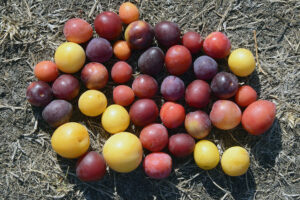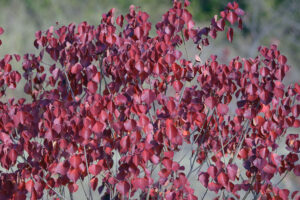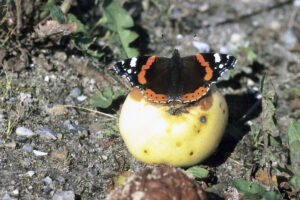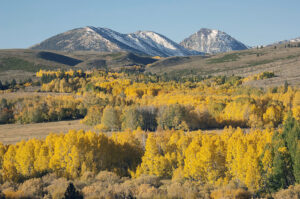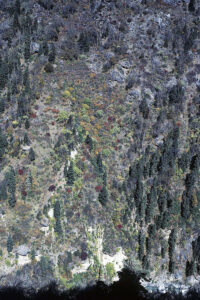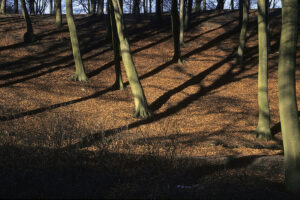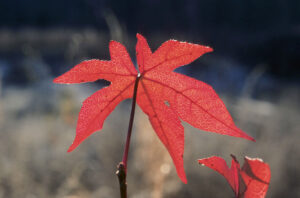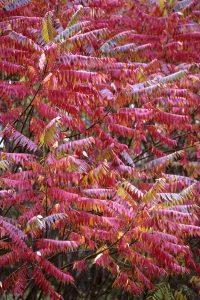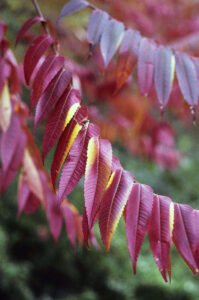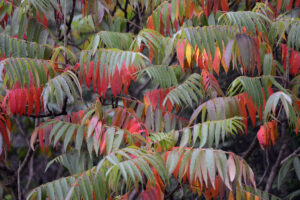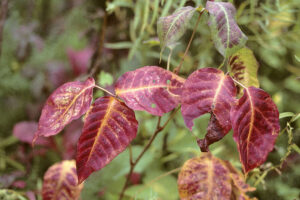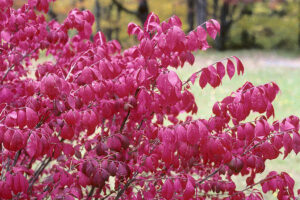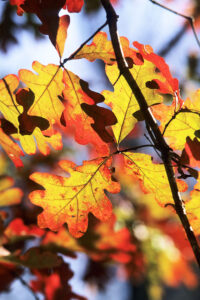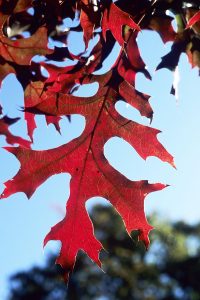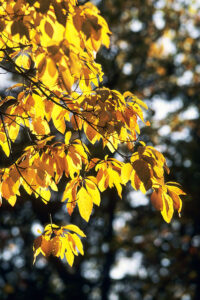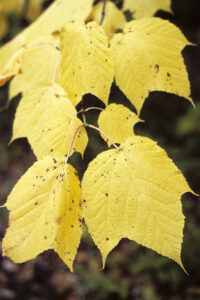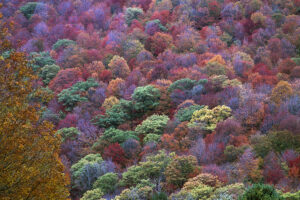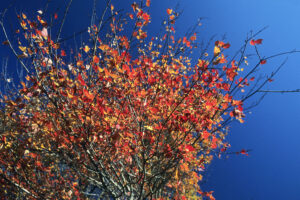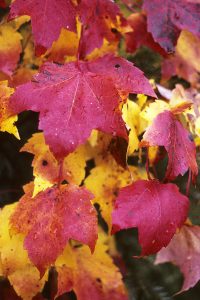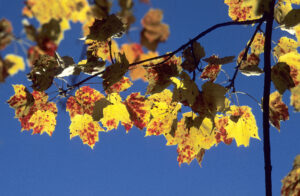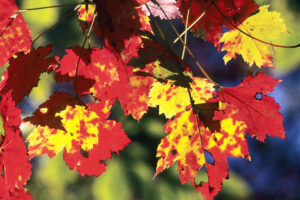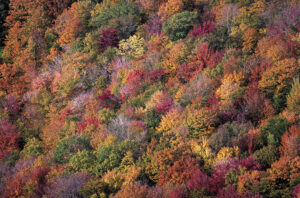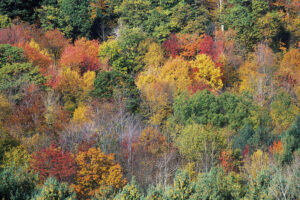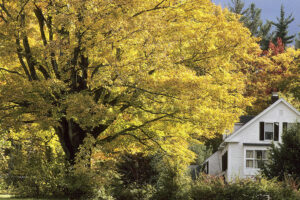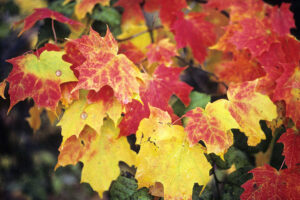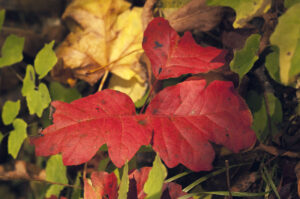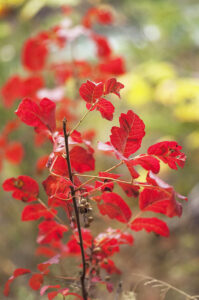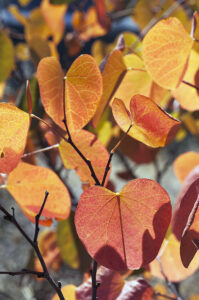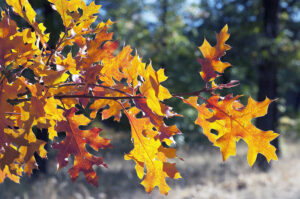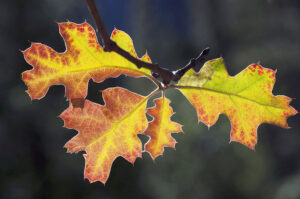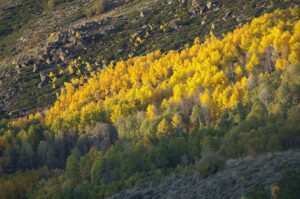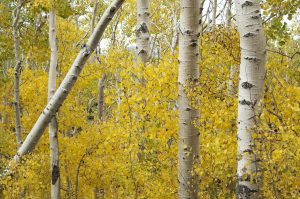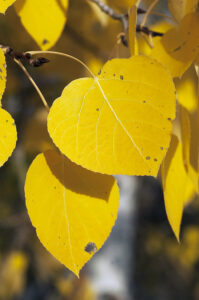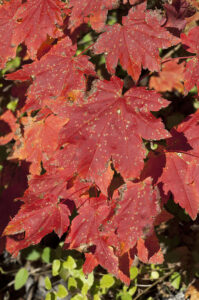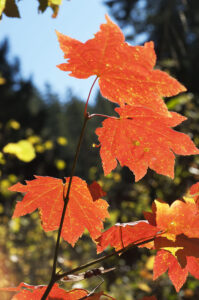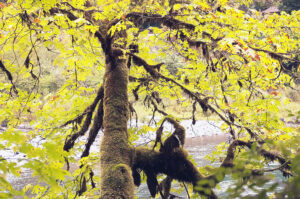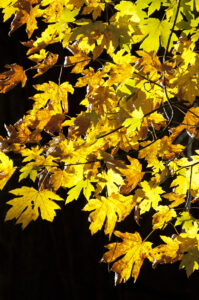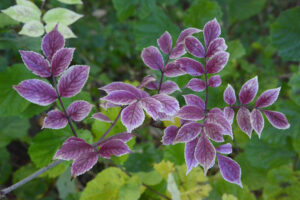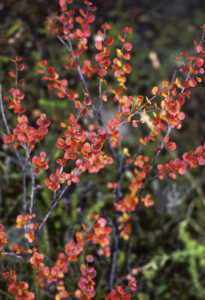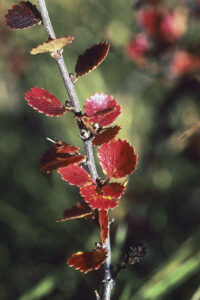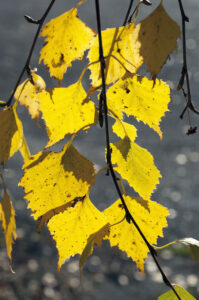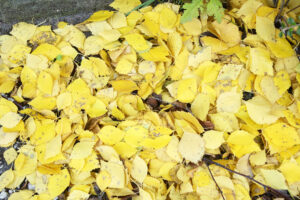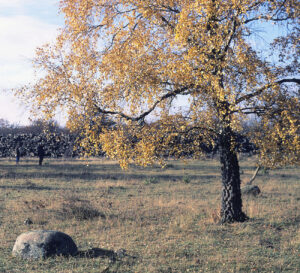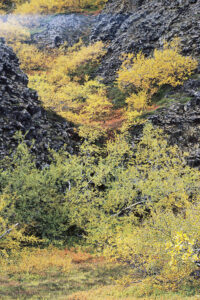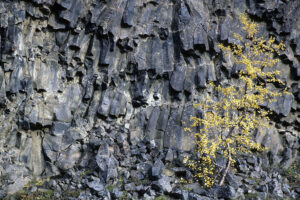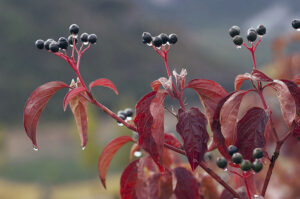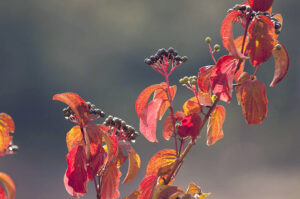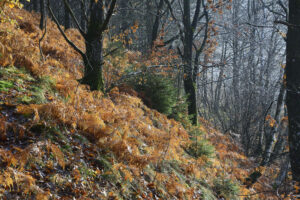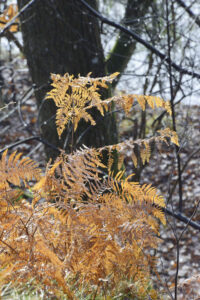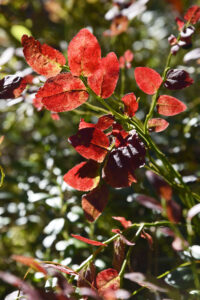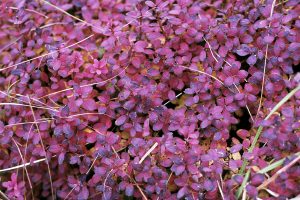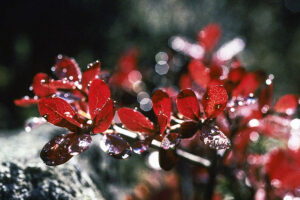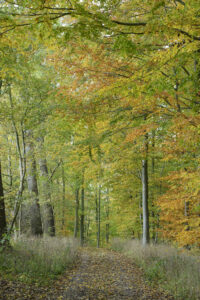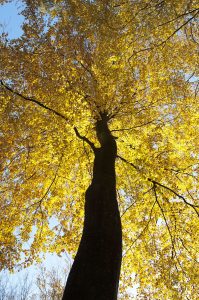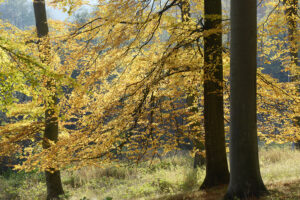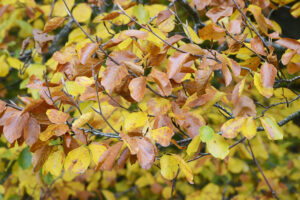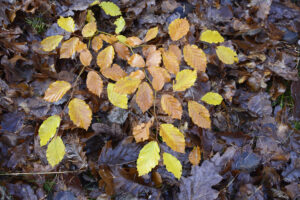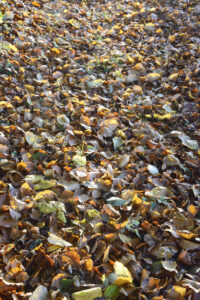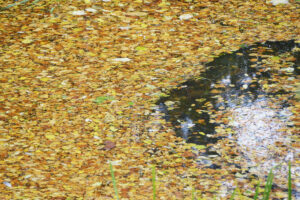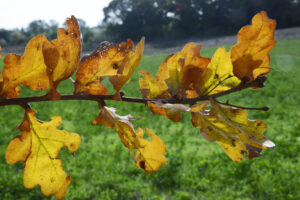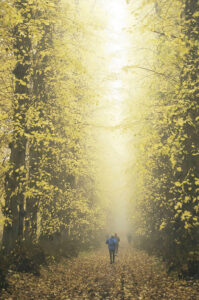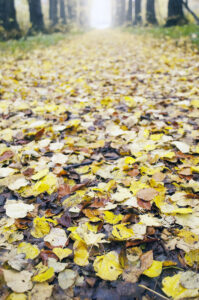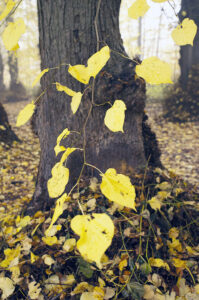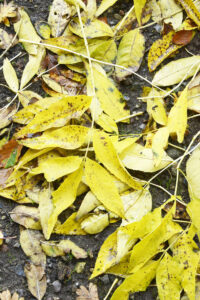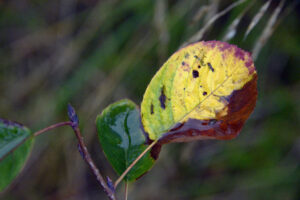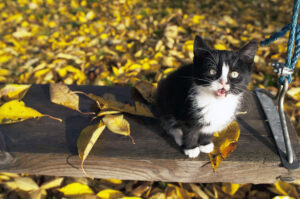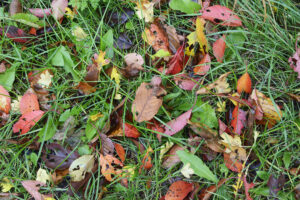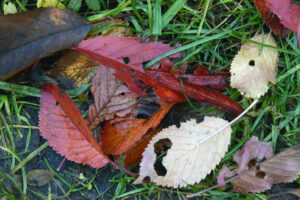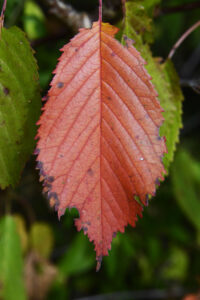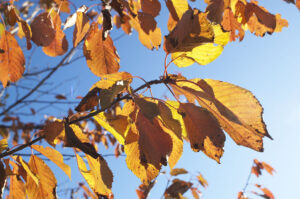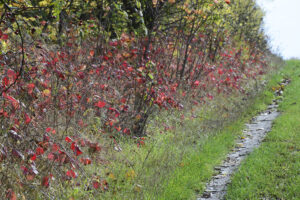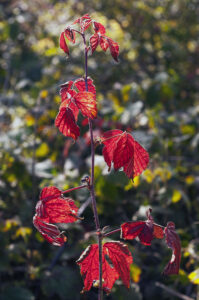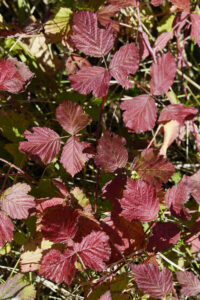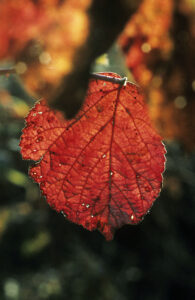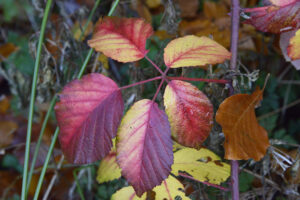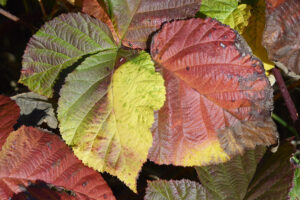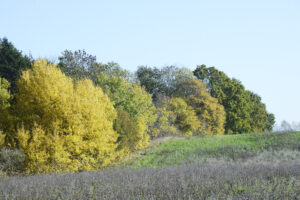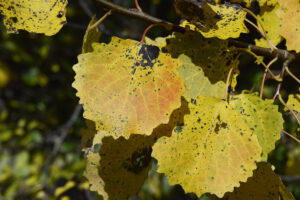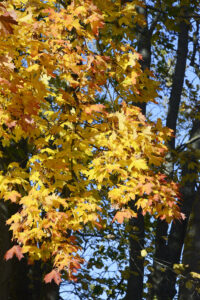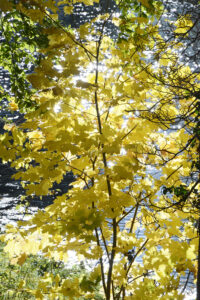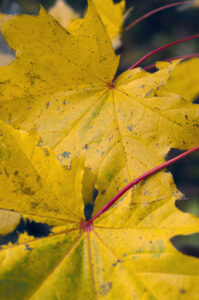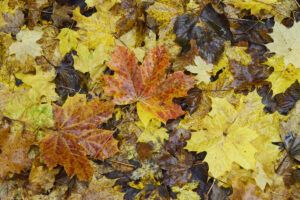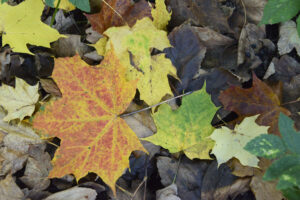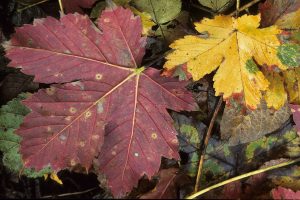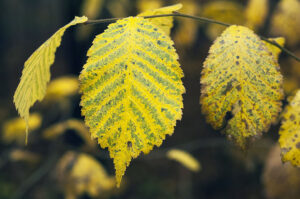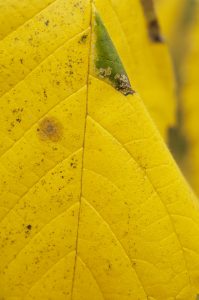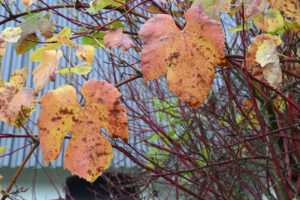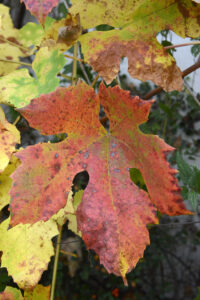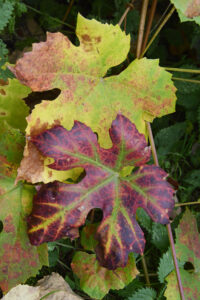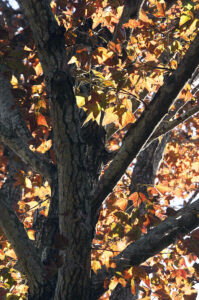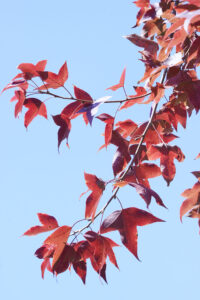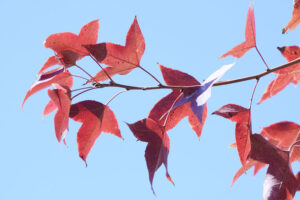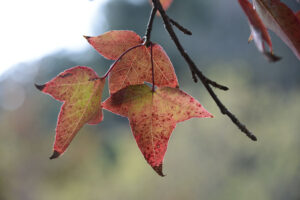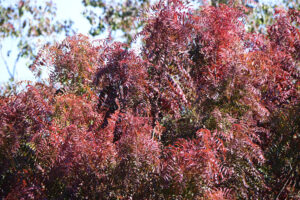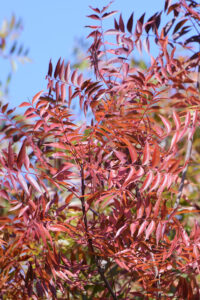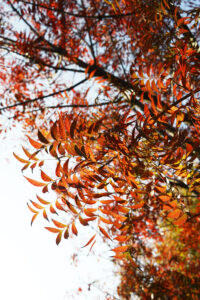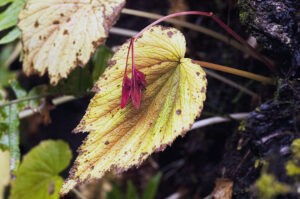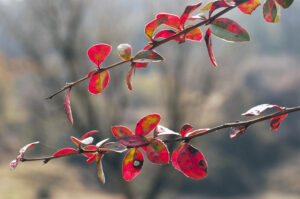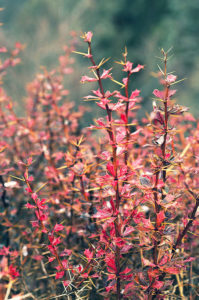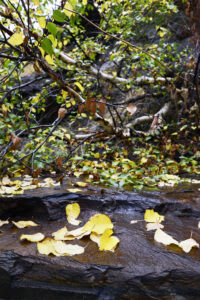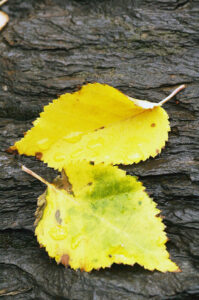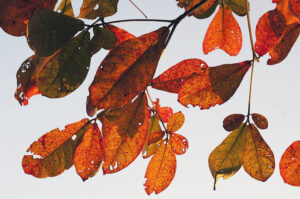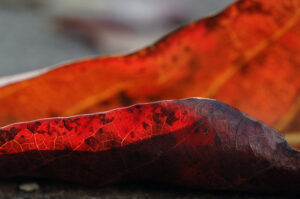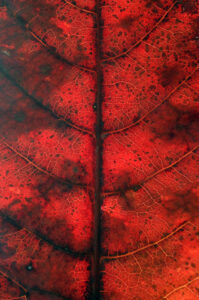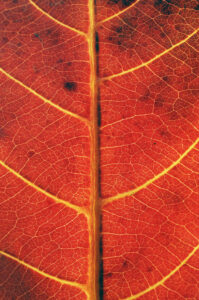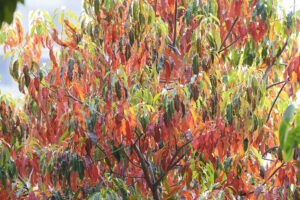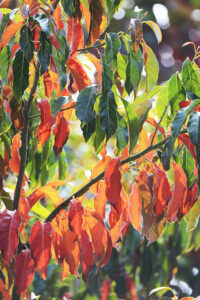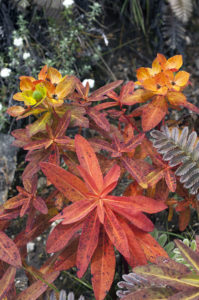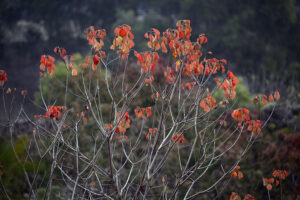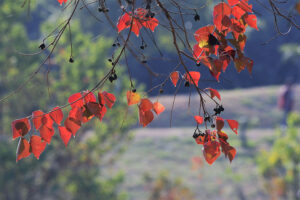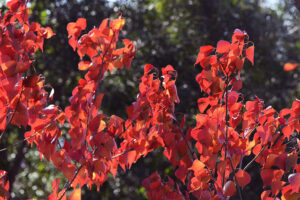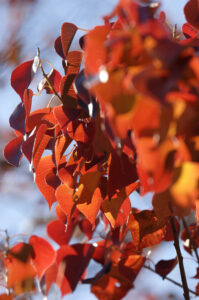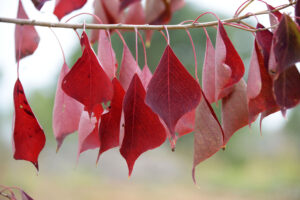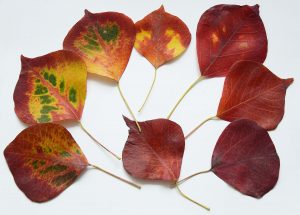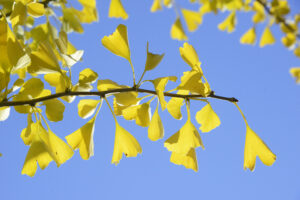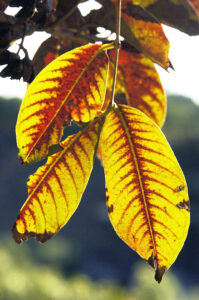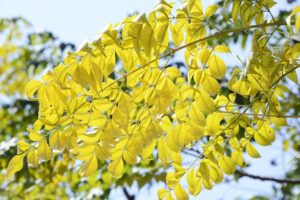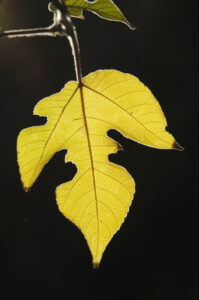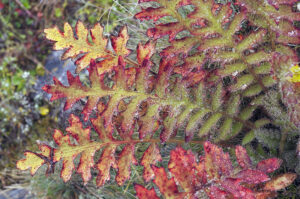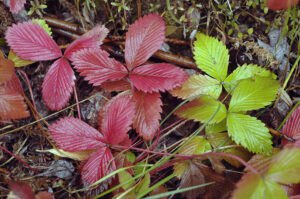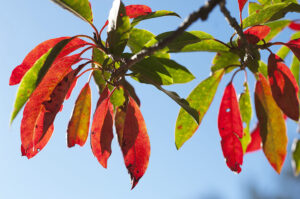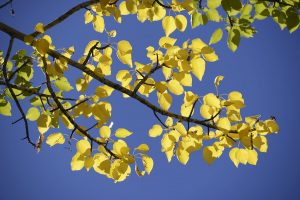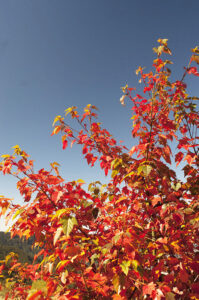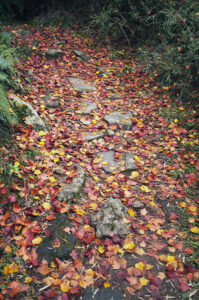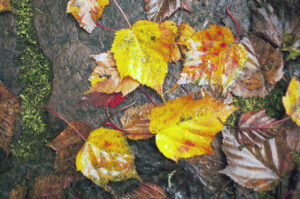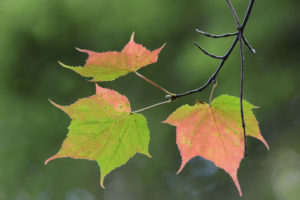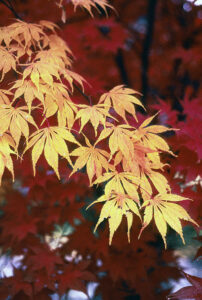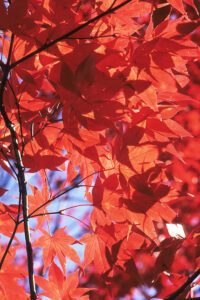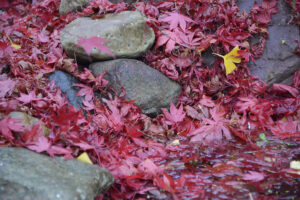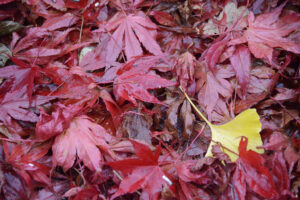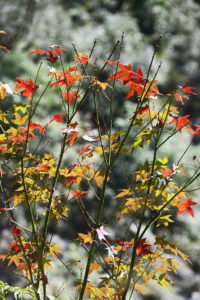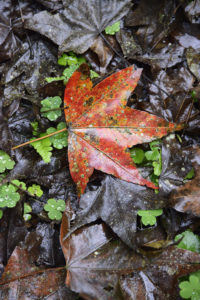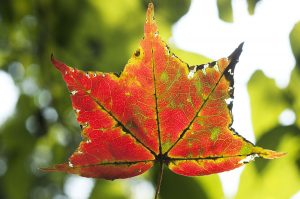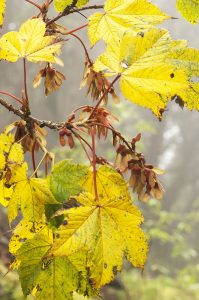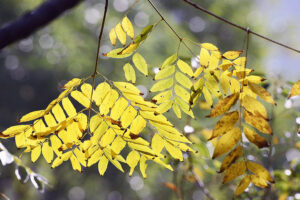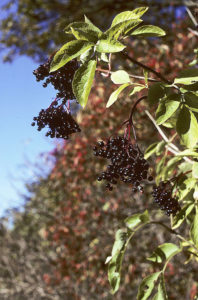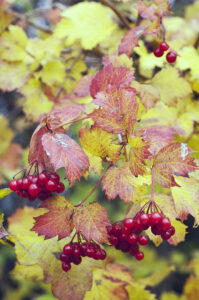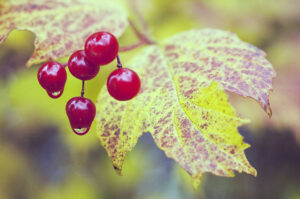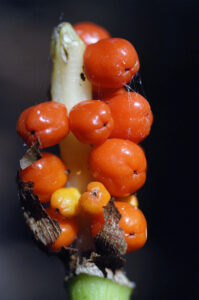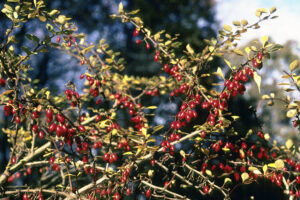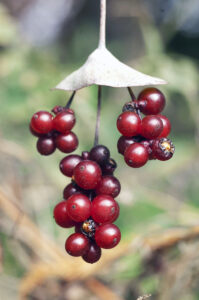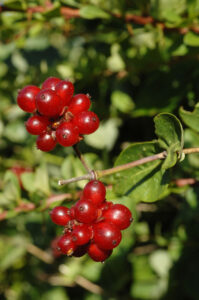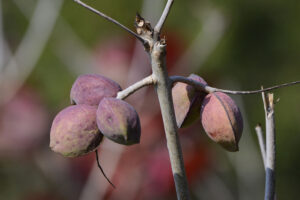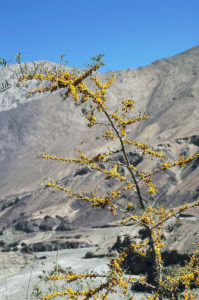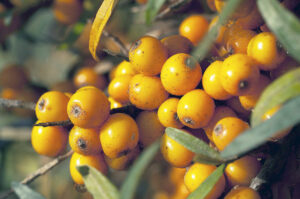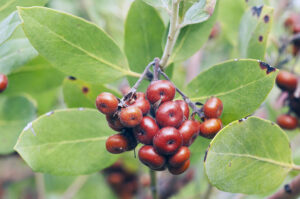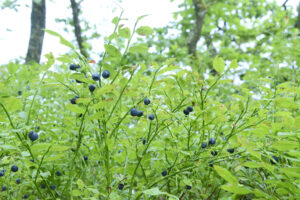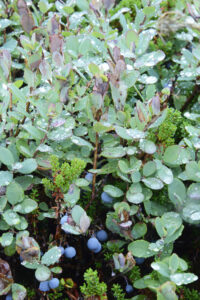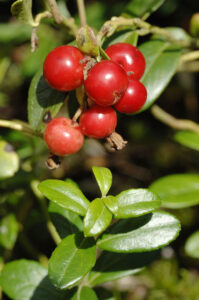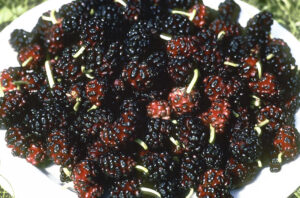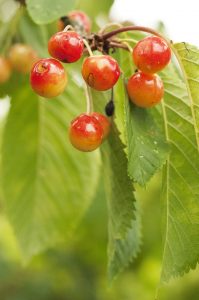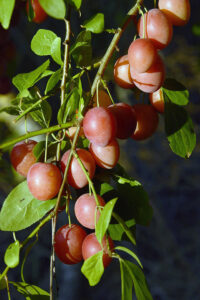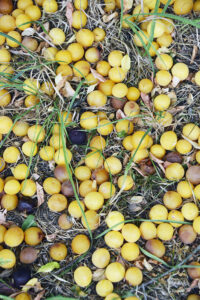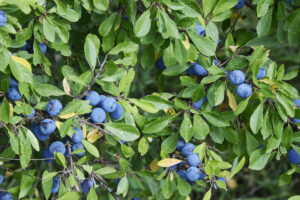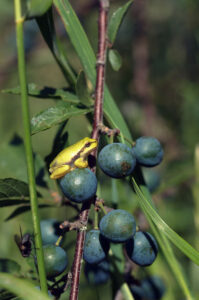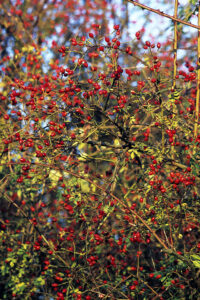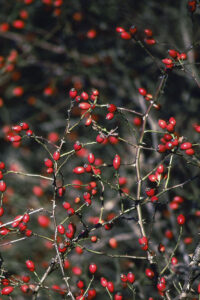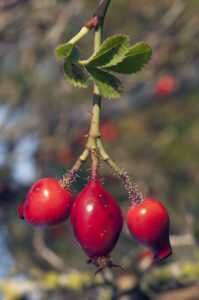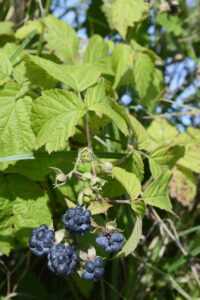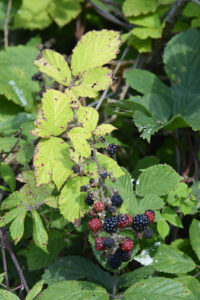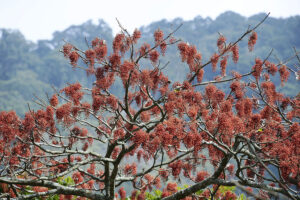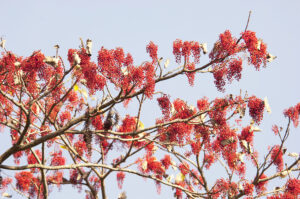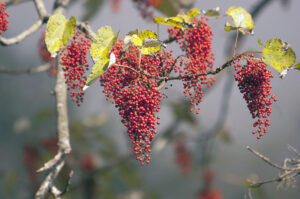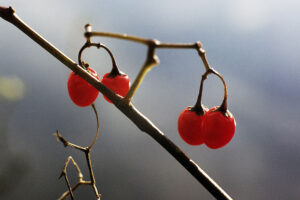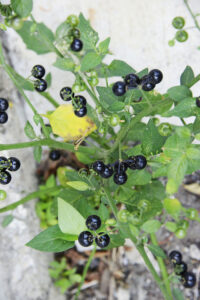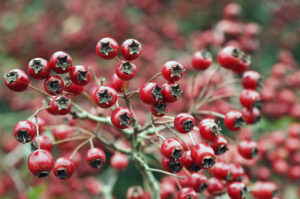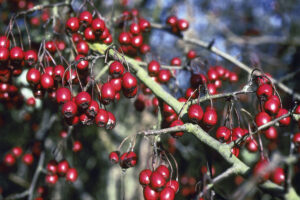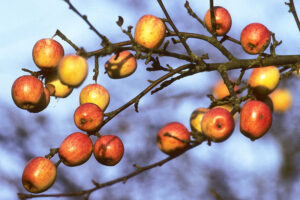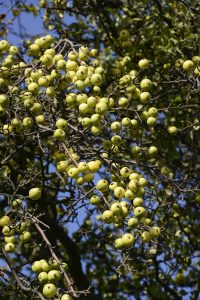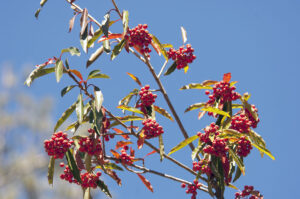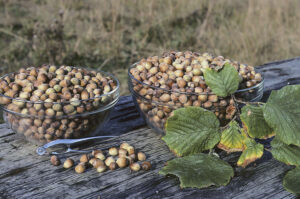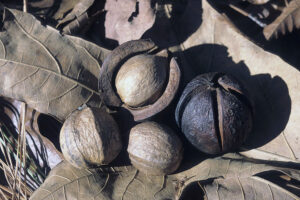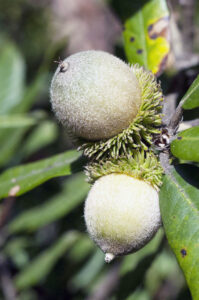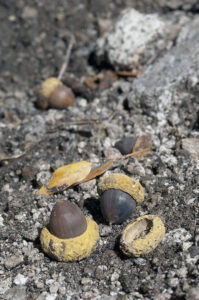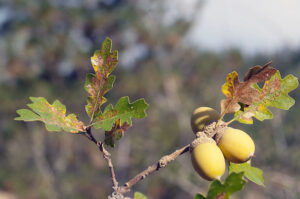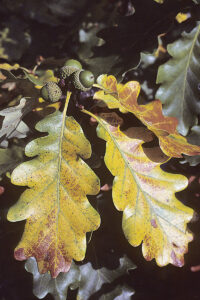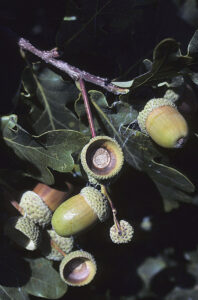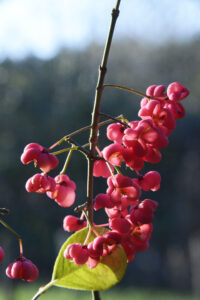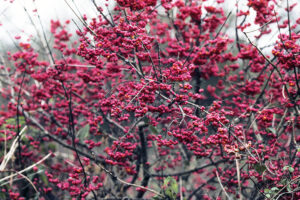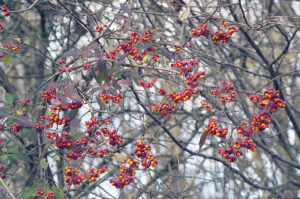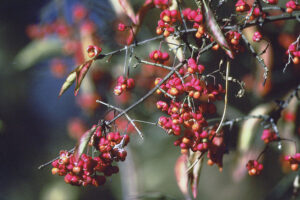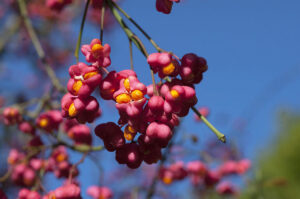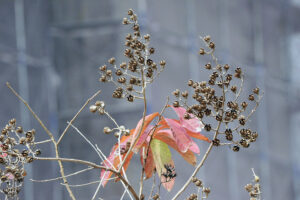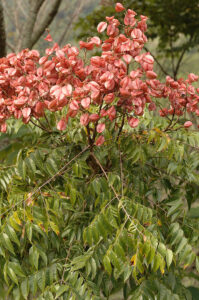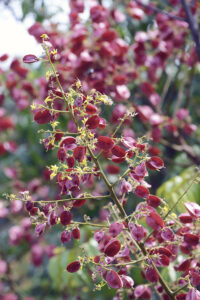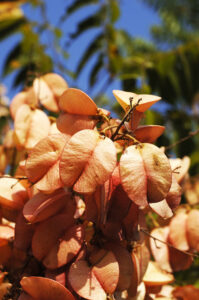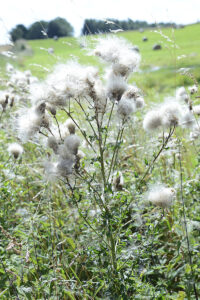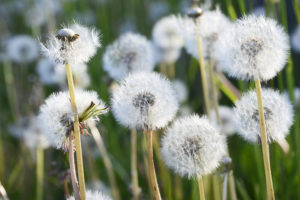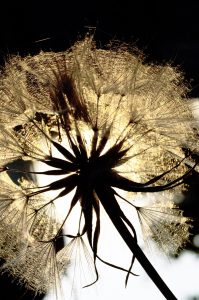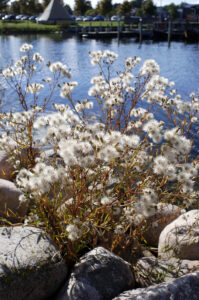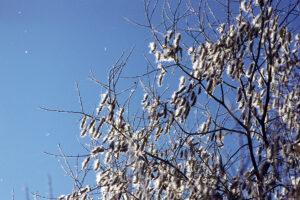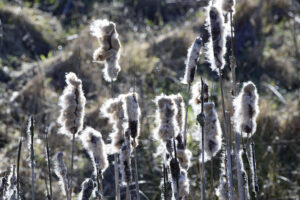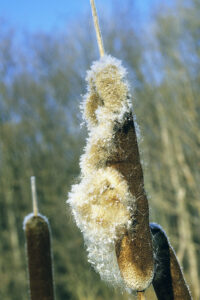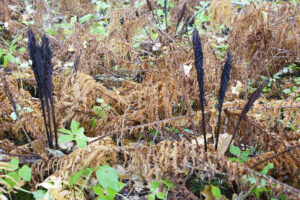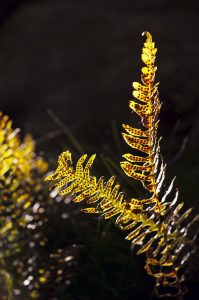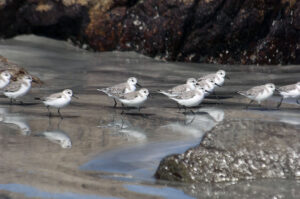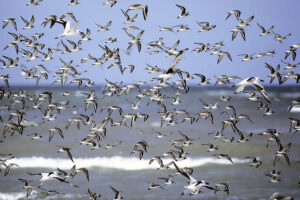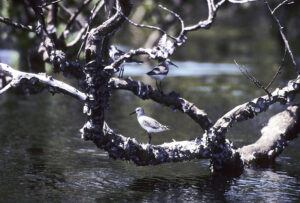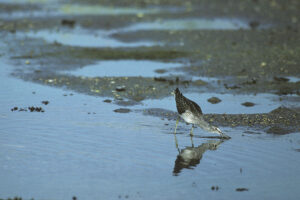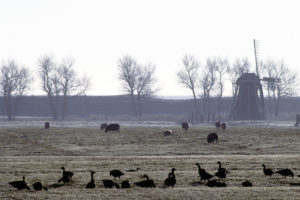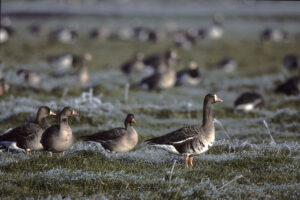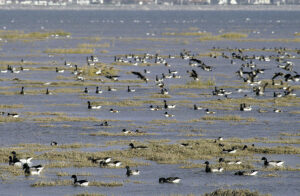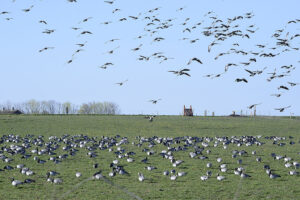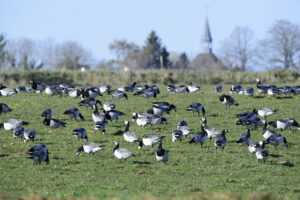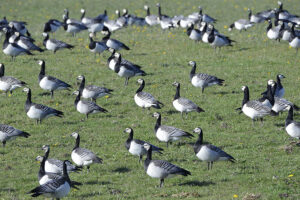Autumn
Wonderful autumn foliage display near Williamstown, Massachusetts, United States. Yellow and orange sugar maples (Acer saccharum) are seen in front, whereas the crimson forest in the background is dominated by red maple (Acer rubrum). (Photo copyright © by Kaj Halberg)
This border terrier is standing in a carpet of fallen leaves from a large cherry tree (Prunus avium), Funen, Denmark. (Photo copyright © by Kaj Halberg)
Colour spectrum and size disparity in fruits of cherry plum (Prunus cerasifera), all from the same area, Jutland, Denmark. (Photo copyright © by Kaj Halberg)
Bright red winter foliage of Chinese tallow-tree (Triadica sebifera), Central Taiwan Science Park, Taichung, Taiwan. (Photos copyright © by Kaj Halberg)
Fallen apples are a popular food item among butterflies, wasps, and flies. This red admiral (Vanessa atalanta) is sucking juice from a decaying apple, Nature Reserve Vorsø, Horsens Fjord, Denmark. (Photo copyright © by Kaj Halberg)
“Autumn is a second spring, when every leaf is a flower.”
Albert Camus (1913-1960), French writer and philosopher
I have been treading on leaves all day until I am autumn-tired.
God knows all the color and forms of leaves I have trodden on and mired.
Perhaps I have put forth too much strength and been too fierce from fear.
I have safely trodden under foot the leaves of another year.
Robert Frost (1874-1963), American poet, in his poem Leaf Treader, 1935
I love the fitfull gusts that shakes
The casement all the day,
And from the mossy elm tree takes
The faded leaf away,
Twirling it by the window-pane
With thousand others down the lane.
(…)
The feather from the raven’s breast
Falls on the stubble lea.
The acorns near the old crow’s nest
Fall pattering down the tree.
The grunting pigs that wait for all
Scramble and hurry where they fall.
John Clare (1793-1864), English poet, in his poem Autumn
In many parts of the world, autumn is a wonderful time, when the foliage of trees and many other plants change colours, adding a vivid, albeit short, touch to the landscape. Berries and other fruits ripen, fungi abound during wetter periods, and birds start their migration southwards to their wintering quarters.
In this picture, autumn foliage brightens the tundra on the Blosseville Coast, eastern Greenland. Arctic willow (Salix arctica) has yellow leaves, bog bilberry (Vaccinium uliginosum) reddish leaves, and alpine bearberry (Arctostaphylos alpina) crimson leaves. Lichens and mosses are also present. (Photo copyright © by Kaj Halberg)
Gorgeous autumn foliage of quaking aspen (Populus tremuloides), covering a mountain slope near Conway Summit, Sierra Nevada, California. (Photo copyright © by Kaj Halberg)
A slope along the Rishi Ganga gorge, Nanda Devi National Park, Uttarakhand, northern India, with scattered Himalayan silver firs (Abies spectabilis) (the dark trees), Himalayan birches (Betula utilis) (yellow foliage), and thickets of barberry (Berberis) (crimson foliage). (Photo copyright © by Kaj Halberg)
Late afternoon sun casts long shadows on a forest floor, covered in fallen leaves of beech (Fagus sylvatica), eastern Jutland, Denmark. (Photo copyright © by Kaj Halberg)
East American autumn foliage
In autumn, hardwood forests of north-eastern North America are a spectacle to behold, with an outstanding foliage display, when leaves turn crimson, wine-red, orange, or yellow. This display is mainly seen from Quebec southwards to Virginia.
Altingiaceae
Liquidambar Sweetgum
A genus with about 15 species, found in eastern North America, Mexico, Central America, Turkey, East and Southeast Asia, and western Indonesia. The fruits of these plants are ball-shaped, hard, and spiky. Pictures, depicting these fruits, are shown on the pages Plants: Burs, and Silhouettes.
The generic name is derived from the Latin liquidus (‘liquid’) and the Arabic anbar, which, via the Moors, became ambar in Spanish. Amber from members of this genus was formerly used in the cosmetic industry.
Formerly, these trees were placed in the witch-hazel family (Hamamelidaceae), but have since been transferred to Altingiaceae.
Liquidambar styraciflua American sweetgum
This tree is known by a number of other popular names, including hazel pine, bilsted, redgum, satin-walnut, and alligator-wood. It is native to south-eastern United States, and is also found in montane areas of southern Mexico and Central America.
The leaves are almost star-shaped, with 5 to 7 pointed lobes.
The specific name is derived from Ancient Greek styrax, the name of the tree Styrax officinalis and its fragrant balsam, and from the Latin fluere (‘to flow’), thus ‘flowing with fragrant gum’.
A close relative, Chinese sweetgum (L. formosana), is presented below in the section Asiatic autumn foliage.
Gorgeous red autumn leaves of American sweetgum, Piedmont National Wildlife Refuge, Georgia. (Photo copyright © by Kaj Halberg)
Anacardiaceae Sumac family
Rhus Sumac
Sumacs are a genus of about 35 species, distributed in subtropical and temperate areas, especially around the Mediterranean, and in Asia, Australia, and North America.
The generic name is a Latinized version of Ancient Greek rhous, the name of sumac. This word is derived from Ancient Syriac summaq (‘red’), referring to the red fruits of the genus. They have an acrid taste and are used as a spice in the Middle East.
Many other species, which were formerly placed in Rhus, have since been transferred to the genus Searsia, others to Toxicodendron, including poison ivy (below), and poison oak, presented in the section West American autumn foliage.
Rhus glabra Smooth sumac
This shrub, also known as white sumac, upland sumac, or scarlet sumac, is very common in the eastern half of the United States, with a patchy occurrence in southern Canada, the western U.S., and in Tamaulipas, north-eastern Mexico.
It produces an abundance of berries, which are eagerly sought out by birds. The seeds, which pass unharmed through their gut, are spread with the bird droppings and are thus able to colonize open areas and forest edges.
Brilliant autumn foliage of smooth sumac, Williamsburg, Massachusetts. (Photos copyright © by Kaj Halberg)
Rhus typhina Staghorn sumac
This species is found in eastern North America, primarily in south-eastern Canada and from the Great Lakes eastwards to the Appalachian Mountains, with a spotty occurrence westwards to Minnesota, southwards to Mississippi. It is widely cultivated as an ornamental elsewhere in temperate areas.
In North America, the fruits are soaked in cold water to make ‘pink lemonade’, a refreshing beverage, rich in vitamin C.
When describing this plant in 1756, Swedish naturalist Carl Linnaeus (1707-1778) used the phrase Ramis hirtis uti typhi cervini, meaning “the branches are rough like antlers in velvet.”
Various autumn colours on a staghorn sumac, naturalized in Nature Reserve Vorsø, Horsens Fjord, Denmark. (Photo copyright © by Kaj Halberg)
Toxicodendron
Members of this genus, which contains about 28 species, were previously placed in the genus Rhus (above). They are found in the Americas, from Canada southwards to Bolivia, and in eastern Asia, from Sakhalin Island and Japan southwards to Indonesia, westwards to Pakistan.
The generic name is derived from Ancient Greek toxikos (‘poison’) and dendron (‘tree’).
Toxicodendron radicans Poison ivy
The only thing that poison ivy has in common with the true ivy (Hedera helix) is its climbing habit. This plant, which was formerly called Rhus radicans, is very common in the eastern half of North America, from Labrador southwards to Texas and Florida.
As with other members of this genus, it contains the toxic urushiol, which causes rashes and other allergic reactions in some people. In his delightful book All about Weeds, American botanist Edwin Spencer (1881-1964) writes about it: “With alliterations, we may almost truthfully say ‘the worst weed of the woods’ or ‘the worst weed of waste places’ is the poison ivy. If its toxin affected the skin of every one as it does that of a few, it would not be necessary to qualify these allitterations. They would be literally true. This is the one weed, however, that every one who lives in the country, and all who visit it, should know. Those who are immune to its poison have nothing to fear, but no one knows whether he is immune or not until he has come in contact with some part of the plant. If he is susceptible he will long remember that day, and if he is wise he will develop his observational powers, until they equal those of a first-class botanist, when he approaches a likely habitat of this snake of the woods.”
In his excellent book The Green Pharmacy, American botanist and herbalist James A. Duke (1929-2017) recommends the juice of soapwort (Saponaria officinalis) as the best remedy, if you have been into contact with poison ivy or other Toxicodendron species. Smear the juice over the affected area to neutralize the poison.
The specific name is Latin, meaning ‘taking root’, from radix (‘root’), alluding to the spreading roots of this plant.
A close relative, the western poison oak (T. diversilobum), is presented below in the section West American autumn foliage.
Autumn foliage of poison ivy, Muttontown Preserve, Long Island. (Photo copyright © by Kaj Halberg)
Celastraceae Staff-tree family
Euonymus Spindle tree, burning-bush
A large genus with about 130 species of deciduous or evergreen shrubs, small trees, or climbers. Most species are native to eastern Asia, with 50 species endemic to China. Others occur in Europe, northern Africa, Madagascar, Indonesia, New Guinea, eastern Australia, North America, Mexico, and Central America.
The generic name is derived from Ancient Greek eus (‘good’) and onoma (‘name’). It is not clear why Swedish naturalist Carl Linnaeus (1707-1778) applied this name to this genus.
Euonymus atropurpureus Eastern burning-bush
This bush is native to eastern North America, primarily found in a huge area south of the Great Lakes, but with small, scattered populations elsewhere, from Minnesota and Ontario southwards to Texas and Georgia. It is also widely cultivated.
Formerly, the powdered bark was used by native tribes and pioneers as a purgative.
The specific name is derived from the Latin ater (‘dark’) and purpureus (‘purple’), alluding to the autumn colour of this species.
A close relative, the European spindle tree (E. europaeus), is presented below in the section Fruits: Capsules.
Flaming autumn foliage of an eastern burning-bush, cultivated in Massachusetts. (Photo copyright © by Kaj Halberg)
Fagaceae Beech family
Quercus Oak
A genus with about 300-500 species, depending on authority. They are native to the Northern Hemisphere, distributed in the Americas, Asia, Europe, and North Africa.
Male flowers are in pendent catkins, females in mostly erect spikes. The fruit is a nut, called an acorn, partly enclosed in a cup-like structure, the cupule, consisting of overlapping bracts with free tips. (See examples of acorns below in the section Hard-shelled fruits: Acorns.)
The generic name is the classical Latin term for oaks, which probably stems from the name of the Lithuanian god of thunder, Perkunas. In almost all of Europe, the oak was a sacred tree, dedicated to the highest gods, in Greece to Zeus, in Nordic countries to Thor, the god of thunder.
The word oak is from the Anglo-Saxon ek, in ancient Germanic aik, of uncertain origin and meaning.
A number of oaks are presented on the page Plants: Ancient and huge trees.
A few species of eastern American oaks display brilliant autumn foliage.
Quercus alba White oak
This large tree is very common in the north-eastern states, found from Ontario and Quebec southwards through the eastern United States to northern Florida, westwards to Minnesota, and thence southwards to Texas.
Despite its name, the bark of this species is mostly grey, only occasionally white. It can grow very old, some specimens having reached the ripe age of 450 years.
Colourful autumn foliage of white oak, Delaware Water Gap, New Jersey. (Photo copyright © by Kaj Halberg)
Quercus coccinea Scarlet oak
As its name implies, this species has brilliant autumn foliage. It mainly grows on dry, acidic soils in the eastern and central United States, from Maine southwards to Georgia, and thence westwards to Missouri and Louisiana.
The specific name is derived from Ancient Greek kokkinos (‘scarlet’).
Scarlet oak really lives up to its name, as seen from these leaves, encountered in Caleb Smith State Park, Long Island. (Photo copyright © by Kaj Halberg)
Lauraceae Laurel family
Sassafras
The native range of this genus, comprising 3 species, is eastern North America, southern China, Taiwan, and northern Vietnam.
The generic name is of Spanish origin, possibly adapted from an unknown indigenous language.
Sassafras albidum Common sassafras
This smallish tree, which grows to about 18 m tall, is widely distributed in the eastern United States, from Maine southwards to northern Florida, westwards to the Great Lakes and eastern Texas. Its autumn foliage displays many colours: yellow, red, pink, orange, and purple.
Ground leaves of sassafras is an ingredient in home-made root beer, and they also act as a thickener and flavouring in gumbo, a spicy herb, which was used by indigenous tribes in the southern United States, and was later adopted into Louisiana Creole cuisine. (Source: C. Nobles 2009. Gumbo, in: S. Tucker & S. Starr, New Orleans Cuisine: Fourteen Signature Dishes and Their Histories, University Press of Mississippi)
Evening light on autumn foliage of common sassafras, Delaware Water Gap, New Jersey. (Photo copyright © by Kaj Halberg)
Sapindaceae Soapberry family
Acer Maple
In former days, maples, comprising about 130 species of deciduous trees or large shrubs, constituted a separate family, Aceraceae, which is now regarded as belonging to Hippocastanoideae, a subfamily of the soapberry family.
These plants are widespread in the Northern Hemisphere, with most species in Asia, others in Europe, northern Africa, and North and Central America. Only a single species occurs in the Southern Hemisphere.
The generic name is derived from Ancient Greek akros (‘sharp’ or ‘pointed’), alluding to the shape of the leaves.
Acer pensylvanicum Striped maple
This small tree, also known as moose maple, grows to about 10 m tall. It ranges from Nova Scotia and northern Quebec southwards along the Appalachian Mountains to northern Georgia. It is also found at scattered locations westwards to Michigan and Saskatchewan, and in Ohio.
The popular name stems from the striped bark on younger trees.
Autumn leaves of striped maple are of a warm yellow colour, here photographed at Williamsburg, Massachusetts. (Photo copyright © by Kaj Halberg)
Acer rubrum Red maple
Especially gorgeous is the autumn foliage of the red maple, which may display crimson, orange, and yellow on a single leaf. This species, also known as swamp maple, water maple, or soft maple, is one of the most abundant and widespread broad-leaved trees in eastern and central North America, distributed from Newfoundland southwards to Florida, and westwards to Manitoba, Minnesota, and eastern Texas.
It is very adaptable, growing in various types of soil, from swamps to dry areas, and from sea level to about 900 m altitude.
The specific name is derived from the Latin ruber (‘red’).
Autumn forest of red maple and sugar maple (see below), near Cummington, Massachusetts. (Photo copyright © by Kaj Halberg)
Autumn foliage of red maple, Caleb Smith State Park, Long Island. (Photo copyright © by Kaj Halberg)
Wine-coloured and yellow leaves on a red maple, Gorham, New Hampshire. (Photo copyright © by Kaj Halberg)
Flaming red and yellow leaves of red maple, Catskills (top) and Adirondacks, New York State. (Photos copyright © by Kaj Halberg)
Acer saccharum Sugar maple
As its name implies, this tree, also known as rock maple, is an important source of sugar, utilized to produce the celebrated maple syrup. It is distributed from Nova Scotia westwards to Minnesota, southwards to Missouri and Tennessee, and thence north-east to New York State.
It is generally believed that the leaf of sugar maple is depicted on the Canadian national flag, but according to the website canada.ca/en.html, this depiction does not represent any particular maple species.
The specific name is Latin, meaning ‘sugar’, adapted from Ancient Greek sakkharon, ultimately from Sanskrit sarkara, a term used for ground as well as candied sugar.
Wonderful foliage display of sugar maple and red maple in the Catskills, New York State. (Photo copyright © by Kaj Halberg)
Mixed deciduous forest, dominated by sugar maple, with a few red maples (the scarlet trees), near Williamstown, Massachusetts. (Photo copyright © by Kaj Halberg)
Due to its gorgeous foliage display, sugar maple is often planted near houses, as in these pictures from Silver Lake, New Hampshire (top), and Great Barrington, Massachusetts. (Photos copyright © by Kaj Halberg)
Foliage of sugar maple adorns a stone wall near Gorham, New Hampshire. (Photo copyright © by Kaj Halberg)
Similar to red maple, leaves of sugar maple often display several colours on a single leaf, in this case near Gorham, New Hampshire. (Photo copyright © by Kaj Halberg)
West American autumn foliage
Although eastern North America takes the prize, the western part of the continent also has a significant display of autumn colours, as is obvious from the following pictures.
Anacardiaceae Sumac family
Toxicodendron
See section East American autumn foliage above.
Toxicodendron diversilobum Western poison oak
Despite its name, this species, formerly known as Rhus diversiloba, is not even distantly related to oaks, and the name was given due to the similarity of its leaves to oak leaves. It is very common along the Pacific Coast, from British Columbia southwards to Baja California.
As with other members of this genus, poison oak contains a toxic substance, urushiol, which many people are allergic to (see poison ivy above, in section East American autumn foliage).
The specific name is derived from the Latin diversus (‘diverse’), and Ancient Greek lobos (‘lobe’), referring to the leaves.
Autumn foliage of western poison oak, Umpqua National Forest, Oregon. (Photos copyright © by Kaj Halberg)
Fabaceae Pea family
Cercis Redbud, Judas tree
A small genus with about 10 species, found in temperate and subtropical areas of North America, Mexico, southern Europe, and Asia.
The generic name is derived from Ancient Greek kerkis, meaning ‘weaver’s shuttle’, applied by Greek scholar Theophrastos (c. 371 – c. 287 B.C.) to the Mediterranean Judas tree (C. siliquastrum). Presumably, shuttles were made from the wood of this species.
Cercis occidentalis California redbud
This small tree, which grows to 6 m tall, can be identified by its almost circular leaves. It is found mainly in northern California, less abundantly in southern California, Nevada, Utah, and Arizona.
Early in spring, it produces a profusion of pink or purplish flowers.
The specific name is Latin, meaning ‘of the West’.
Autumn foliage of California redbud, near McArthur, Cascade Range, California. (Photo copyright © by Kaj Halberg)
Fagaceae Beech family
Quercus Oak
See section East American autumn foliage above.
Quercus kelloggii California black oak
Found mainly in northern California and western Oregon, this tree grows in foothills and lower mountains. Its occurrence in southern California and Baja California is patchy, but it is common in the Sierra Nevada. Most trees live between 100 and 200 years, but some specimens have been known to be almost 500 years old.
This species is adapted to fire, protected from smaller fires by its thick bark. It is killed by larger fires, but easily sprouts again from the roots. Acorns mainly sprout, when a fire has cleared an area of leaf litter. This was known by several indigenous peoples, who purposely lit fires to renew growths of this tree, whose acorns was a staple food source to them.
The specific name honours American physician and botanist Albert Kellogg (1813-1887), one of the founding members of the California Academy of Sciences.
Leaves of California black oak are deeply cleft, 10-20 cm long. These pictures were taken near McArthur, Cascade Range (top), and in Kings Canyon National Park, Sierra Nevada. (Photos copyright © by Kaj Halberg)
Salicaceae Willow family
Populus Poplar, cottonwood, aspen
This genus contains about 60 species of deciduous trees, some majestic, to 50 m tall, with a trunk diameter to 2,5 m. They are native to the major part of the Northern Hemisphere, from subarctic regions southwards to Mexico, northern Africa, Iran, the Himalaya, and China, and also to East Africa.
The leaves are broad, with a long, slender stalk, which is flattened, making it rustle in the slightest puff of wind. Inflorescences are pendent catkins, with numerous tiny flowers clustered around a central axis, each flower surrounded by papery bracts. The flowers are wind-pollinated, and the fluffy seeds are spread by the wind.
The generic name is the classical Latin word for poplars. The common name cottonwood alludes to the fluffy seeds. The name aspen is derived from aspo, the ancient Proto-Germanic name of poplars.
Populus tremuloides Quaking aspen
In autumn, the foliage of quaking aspen adds vivid splashes of yellow to numerous areas in western North America. This species also has many other names, including golden aspen and trembling poplar. It is the most widely distributed tree in North America, found from Alaska southwards through western Canada and the United States to central Mexico, and in a broad belt across Canada and northern U.S. to Newfoundland and New England, southwards to Pennsylvania.
This tree was named for its leaves, which tremble noisily in the slightest breeze. The Onondaga people called it nut-kie-e, meaning ‘noisy leaf’, and a local poplar species in Louisiana was dubbed langues de femmes (‘women’s talk’) by the French refugees.
The specific name means ‘resembling tremula‘. It refers to the European aspen (P. tremula), presented below in the section European autumn foliage.
Quaking aspens on a mountain slope near Conway Summit, Sierra Nevada, California. The second picture shows the snow-white trunk of this iconic species. (Photos copyright © by Kaj Halberg)
Sapindaceae Soapberry family
Acer Maple
See section East American autumn foliage above.
Acer circinatum Vine maple
This species is usually a shrub, but may grow to a small tree, sometimes reaching a height of 20 m. The common name probably stems from its short, crooked trunk, with twisted, spreading limbs, which somewhat resemble those of the grapevine (Vitis vinifera).
It has a rather limited distribution, found along the Pacific coast from southern British Columbia southwards to northern California, being a colonizer of avalanche areas and open forests, which have been clear-cut by loggers.
In former days, wood of this tree was utilized by native tribes to make bows, frames for fishing nets, snowshoes, and cradle frames. Other tribes boiled the bark of the root and drank this decoction to treat colds. Charcoal made from this species was mixed with water, taken against dysentery and polio.
Wine-red and orange-red autumn foliage of vine maples, both photographed in Umpqua National Forest, Oregon. (Photos copyright © by Kaj Halberg)
Acer macrophyllum Bigleaf maple
As its name implies, this species, also known as Oregon maple, has large leaves – in fact the largest leaves of any maple, often to 30 cm across, with five deeply indented lobes.
Most individuals of this tree are 15-20 m high, but specimens up to 48 m tall have been recorded. It is native to the Pacific Coast, from southernmost Alaska to southern California. Inland, it occurs in the Sierra Nevada, and in central Idaho.
Autumn foliage of bigleaf maple is yellow. This picture shows a large, moss-covered specimen, encountered at the North Umpqua River, Umpqua National Forest, Oregon. (Photo copyright © by Kaj Halberg)
Leaves of a bigleaf maple, illuminated by a patch of sunshine, Humboldt Redwood State Park, California. (Photo copyright © by Kaj Halberg)
European autumn foliage
Compared to the marvellous autumn colours in North America, autumn in Europe is a more subdued affair. However, a number of plants do have gorgeous autumn foliage.
Adoxaceae Moschatel family
Sambucus Elder
The number of elder species is disputed, and there may be anywhere between 25 and 50. These trees, shrubs, or shrubby herbs are distributed in temperate and subtropical areas, mostly in the Northern Hemisphere, with some members in parts of Australasia and South America.
In the past, this genus was placed in the family Sambucaceae, but was then transferred to the honeysuckle family (Caprifoliaceae). However, recent genetic studies have caused it to be moved yet another time, to the moschatel family.
The generic name is from the Greek sambuca, the name of an ancient instrument of Asian origin. Presumably, the soft pith was removed from the twigs to make flutes. The name elder is from Anglo-Saxon, aeld, meaning ’fire’ – the hollow stems were used to kindle a fire.
Sambucus nigra Common elder
Common elder is native to Europe and North Africa, eastwards to the Caucasus, and has also become naturalized in North America.
The popular names pipe tree and bore tree stem from the habit of removing the pith of elder branches to produce pipes. The same procedure would make pop-guns, which were popular among small boys. English herbalist Nicholas Culpeper (1616-1654) writes: ”It is needless to write any description of this, since every boy that plays with a pop-gun will not mistake another tree for the elder.”
The specific name is Latin, meaning ‘black’, alluding to the colour of the berries (see section Berries and berry-like fruits below).
The role of elder in folklore and traditional medicine is described in depth on the page Plants: Plants in folklore and poetry.
Autumn colours of elder leaves is usually a subdued affair, but occasionally they may display brilliant colours, like this specimen in eastern Funen, Denmark. (Photo copyright © by Kaj Halberg)
Betulaceae Birch family
Betula Birch
A genus with 50-60 species, distributed in temperate and subarctic areas of Europe, Asia, and the Americas. Male and female flowers are borne in catkins, in separate inflorescences, males pendulous, females erect. The fruit fragments into 3-lobed scales and winged nutlets when mature.
The generic name is derived from Celtic betu (’glue’), referring to the fact that Celts extracted a glue-like substance from birch sap. In certain areas with Gaelic-speaking peoples, including Wales and Brittany, birch is still called bezuenn or bedwen.
The common name is derived from Proto-Germanic berko, in all probability rooted in Sanskrit bhurja, the name of a species of birch.
In Norse religion, the birch represented Freya, the Great Mother Goddess, and among Celtic peoples the star goddess, Arianrhod, whose caer (‘throne’) was situated in the Corona Borealis (Northern Lights). She was invoked through the birch to assist in births and initiations.
Previously, the soft birch wood was carved into numerous items, including furniture, cups, bowls, bobbins, cradles, and toys. The bark separates into thin strips, which peels off easily. It is tough, water proof and rot proof, making it perfect as roofing material. It was also utilized to make buckets, baskets, bottles, plates, and shoes, and for writing and drawing. Due to its content of volatile oils, rolled-up bark could be used as torches.
Betula nana Dwarf birch
As its name implies, this species is small, rarely growing taller than 1.2 m. It has a circumpolar distribution, mainly found in the Arctic. At the southern limits of its range, such as Scotland and the Alps, it is restricted to mountains. In the latter area, it grows up to an altitude of 2,200 m.
In Scotland, many populations have declined drastically in recent years, presumably due to global warming.
The specific name is Latin, meaning ‘dwarf’.
In Iceland, dwarf birch is very common, here photographed at Jökulsá á Fjöllum River (top), and on the mountain Fornastaðafjall, near Akureyri. (Photos copyright © by Kaj Halberg)
Betula pendula Silver birch
This tree is widespread and common from Europe and the Caucasus eastwards across Siberia to the Pacific, and thence southwards to northern China and Japan.
The specific name means ’pendulous’ or ‘hanging’ in Latin, referring to the pendulous outer branches of this species.
Autumn foliage of silver birch, Zealand, Denmark. (Photo copyright © by Kaj Halberg)
Fallen leaves of silver birch, forming a carpet, Funen, Denmark. (Photo copyright © by Kaj Halberg)
Betula pubescens Downy birch
Like silver birch, this species is widespread and common in Europe and the Caucasus, and thence eastwards across Siberia to the Pacific.
The specific name is derived from the Latin pubes (’downy’), like the common name alluding to the downy twigs of this tree.
In former days, birch populations in Arctic regions were regarded as a subspecies, tortuosa, of the downy birch. However, genetic research indicates that it evolved from hybridization between downy birch and dwarf birch, and today most authorities regard it as a variety of the former, named B. pubescens var. pumila.
An old downy birch, displaying autumn foliage, Ismanstorp, Öland, Sweden. (Photo copyright © by Kaj Halberg)
Millions of years ago, volcanic activity in today’s northern Iceland brought fluid basaltic lava to the surface, where it formed a plateau. As the lava cooled, it contracted and fractured in a similar way to drying mud. As the lava cooled further, these cracks penetrated downwards, forming 6-sided (sometimes 4-, 5-, and 7-sided) columns. Further volcanic activity since pushed some of the columns into a horizontal position.
Some of these formations, named Hljoðaklettar, have withstood erosion by the Jökulsá á Fjöllum River. Hljoðaklettar means ‘Echo Rocks’, so named due to the peculiar acoustics of the area, which produce echoes.
Autumn foliage of arctic downy birches adds a touch of colour to the otherwise sombre Hljoðaklettar rocks. (Photos copyright © by Kaj Halberg)
Cornaceae Dogwood family
Cornus Dogwood
The only genus of the family, containing about 55 species, which are widespread in northern temperate areas, with a single species in tropical Africa and one or two in South America. The flowers are in heads or flat-topped clusters, in some species with large, coloured bracts.
The generic name is derived from the Latin cornu (‘horn’), alluding to the hard wood of Cornelian cherry-dogwood (Cornus mas). It is so dense that it will sink in water.
The prefix dog may imply that the fruits of common dogwood (below) are of little value, having a bitter taste. Alternatively, it may refer to the former usage of dogwood shoots, which were sharpened and used by farmers as cattle prods, called dags. Skewers were also made from the tough and durable wood.
Cornus sanguinea Common dogwood
This deciduous shrub, usually 2-3 m tall, occasionally up to 6 m, is native to the major part of Europe, from Ireland, Scotland, and southern Norway southwards to Spain, southern Italy and Greece, eastwards to western Russia, Ukraine, Turkey, and the Caucasus. Elsewhere, it is widely cultivated as an ornamental due to its reddish stems, which are quite showy, when the leaves have been shed.
In former days, oil from the berries was used as lamp fuel. Medicinally, they were utilized as an emetic, whereas the astringent bark was used as a febrifuge.
In 1991, the well-preserved body of a Stone Age hunter was discovered in a glacier in the Alps. Ötzi the Iceman, as he was dubbed, died about 5,300 years ago, presumably caught in a snowstorm. His arrow shafts were made from dogwood and viburnum wood. (Source: K. Spindler 1994. The Man in the Ice)
The specific name is Latin, meaning ‘blood-coloured’, which may refer either to the red stems or to the autumn foliage.
Raindrops hang like pearls on autumn leaves and fruits of this common dogwood, Valle Teña, Aragon, Spain. (Photos copyright © by Kaj Halberg)
Dennstaedtiaceae
Pteridium
This genus contains about 18 species, distributed almost globally, with the exception of polar regions.
The generic name is derived from Ancient Greek pteris (‘fern’) and ium, a suffix forming adjectives.
Pteridium aquilinum Bracken
Originally, bracken was native to temperate and subarctic areas of Eurasia, and from northern Africa eastwards across the Middle East to Iran, with disjunct populations in Ethiopia and Yemen. However, it has since spread to all continents, except Antarctica. It readily invades abandoned fields and pastures, where it can cover huge areas, prohibiting growth of other species.
The specific name is derived from the Latin aquila (‘eagle’). Dutch philosopher and theologian Desiderius Erasmus Roterodamus (1466-1536), in English known as Erasmus of Rotterdam, said that the pattern of the fibres seen in a transverse section of the leaf-stalk resembled a double-headed eagle, and in 1755, in his reprint of Flora Suecica, Swedish naturalist Carl Linnaeus (1707-1778) explains that the name refers to the image of an eagle, seen in the transverse section of the root.
Autumn foliage of bracken attains a lovely golden colour. – Jutland, Denmark. (Photos copyright © by Kaj Halberg)
Ericaceae Heather family
Vaccinium Blueberry, bilberry, and allies
A huge genus with about 450 species of shrubs or shrublets, found throughout the Northern Hemisphere, and also in tropical mountains of Asia and Central and South America, and a few species in Africa and on Madagascar.
Blueberry is the name of 21 small shrubs of this genus, 20 of which are indigenous to North America, including the European blueberry (below). The remaining species, Korean blueberry (V. koreanum), is restricted to Korea and the neighbouring Liaoning Province of China.
The generic name is the classical Latin name of blueberries.
Vaccinium myrtillus European blueberry, common bilberry
This dwarf shrub is abundant on acidic soils in the major part of Europe, southwards to the Mediterranean, in northern and central Asia, eastwards to Japan, and in western North America.
The specific name is derived from Ancient Greek myrtos (‘myrtle’), and the Latin illus, a diminutive suffix, thus ‘the small myrtle’, alluding to the myrtle-like leaves.
A picture, depicting the delicious fruits, is shown below in the section Berries and berry-like fruits.
Autumn foliage of European blueberry, Jutland, Denmark (top), and Byrums Sandfelt, Öland, Sweden. (Photos copyright © by Kaj Halberg)
Vaccinium uliginosum Bog bilberry
Another dwarf shrub with an enormous distribution, found in temperate and subarctic regions of the Northern Hemisphere, besides isolated populations in montane areas, including the Pyrenees, the Alps, and the Caucasus in Europe, the Sierra Nevada and the Rocky Mountains in North America, and mountains in Mongolia, China, Korea, and Japan.
The berries resemble those of European blueberry, but have a slightly acidic taste. They are depicted below in the section Berries and berry-like fruits.
The specific name is derived from the Latin uligo (‘dampness’), referring to the fact that the prime habitat of this species is swampy areas.
This large growth of bog bilberry, growing in Nature Reserve Tipperne, Jutland, Denmark, displays a fantastic reddish-purple autumn foliage. (Photo copyright © by Kaj Halberg)
A recent shower has adorned the red autumn foliage of this bog bilberry with countless ‘pearls’. – Fornastaðafjall, near Akureyri, northern Iceland. (Photo copyright © by Kaj Halberg)
Fagaceae Beech family
Fagus Beeches
Beeches are a genus of 10 to 13 species of trees, native to temperate and subtropical areas of Europe, Asia, and North America.
The generic name is the classical Latin word for beeches.
Fagus sylvatica European beech
This large tree, which may occasionally grow to 50 m tall, is largely restricted to Europe, occurring from England and the Pyrenees eastwards to Poland and Ukraine, and from southern Sweden southwards to Italy and the Balkans, with a patchy occurrence in southern Norway, central Spain, and Turkey. In the Balkans, it hybridizes with the oriental beech (F. orientalis).
The specific name is derived from the Latin silva (‘forest’) and aticus (‘pertaining to’), thus ‘growing in forests’.
Other pictures, depicting this tree, are shown on the pages Plants: Ancient and huge trees, and Nature: Nature’s patterns.
Autumn forest, dominated by beech, Funen, Denmark. (Photo copyright © by Kaj Halberg)
Large specimens of European may have a trunk diameter of up to 3 m. – These were photographed in Zealand, Denmark. (Photos copyright © by Kaj Halberg)
Cyclists in a foggy beech forest, Jægerspris, Zealand, Denmark. (Photo copyright © by Kaj Halberg)
Autumn foliage of beech, Funen, Denmark. (Photos copyright © by Kaj Halberg)
Autumn foliage of beech, central Jutland, Denmark. (Photo copyright © by Kaj Halberg)
Fallen leaves of beech create a carpet, Funen, Denmark. The yellow leaves are common hazel (Corylus avellana), the smaller green ones goat willow (Salix caprea). (Photo copyright © by Kaj Halberg)
Beech leaves, and a few leaves of common elm (Ulmus glabra), have fallen into a moat, Nyborg Castle, Funen, Denmark. (Photo copyright © by Kaj Halberg)
Quercus Oak
See section East American autumn foliage above.
Quercus robur Common oak
Common oak, also known as English oak or pedunculate oak, is native to the major part of Europe, eastwards through Turkey to the Caucasus and northern Iran.
The specific name is Latin, originally meaning ‘reddish’, but later also ‘strong’ or ‘hard’, referring to the hard, dark heartwood of the common oak.
Other pictures, depicting common oaks, may be seen on the pages Plants: Ancient and huge trees, and Plants: Plants in folklore and poetry.
Autumn foliage of common oak, Funen, Denmark. (Photo copyright © by Kaj Halberg)
Malvaceae Mallow family
Tilia Linden, basswood, lime tree
A genus of about 30 species of trees or large bushes, native to temperate areas of the Northern Hemisphere, with the greatest diversity in Asia. Previously, they were placed in a separate family, Tiliaceae, which has now been included in the mallow family.
The generic name is derived from the Greek tilos (’fibre’), referring to the use of the bark as bast. The name linden was adopted from the old Norse name of the plant, lind. In Britain, linden trees are sometimes called lime, probably a corruption of lind.
In prehistoric times, linden trees were sacred to many Germanic and Slavic tribes. In the Norse religion, they were dedicated to Odin’s wife Frigg, goddess of wisdom and foreknowledge. Later, lindens were worshipped as a symbol of knowledge, often planted in the centre of the village, where the elders would meet to discuss various issues.
Due to their content of essential oils, linden flowers emit a powerful fragrance, and tea made from dried flowers is a popular drink in many countries, in France called tilleul, in Italy tiglio, and in the Unites States basswood tea. The flowers supply excellent honey, and during the Middle Ages, linden trees were often planted around monasteries and castles to provide honey.
The role of linden trees in folklore and folk medicine is described in depth on the page Plants: Plants in folklore and poetry.
Tilia × europaea Common linden
This natural hybrid between small-leaved linden (T. cordata) and large-leaved linden (T. platyphyllos) is widely cultivated, and has also become naturalized at scattered locations across Europe.
Autumn foliage of linden trees is of a warm yellow colour. These pictures show common linden trees and fallen leaves at Jægerspris, northern Zealand, Denmark. (Photos copyright © by Kaj Halberg)
Oleaceae Olive family
Fraxinus Ash
These trees, comprising about 58 species, are widespread in temperate and subtropical regions of the Northern Hemisphere, and some species also occur in tropical areas of Mexico, Central America, Indochina, the Philippines, and Indonesia.
The generic name is derived from Proto-Italic fraksinos, originally a Proto-Indo-European word for birch trees. The connection to birches is hard to see.
Fraxinus excelsior Common ash
A common tree, native to almost the entire Europe, eastwards to the Caucasus and the Alborz Mountains in northern Iran. It has also become naturalized a few places in New Zealand, the United States, and Canada.
In later years, populations of ash have been much reduced by ash dieback, a disease caused by a fungus, Hymenoscyphus fraxineus, previously called Chalara fraxinea. Most trees that contract this disease die after a few years. However, research has shown that some trees have resistance to it.
The specific name is derived from the Latin excelsus (‘lofty’) and ior, a suffix forming adjectives.
Autumn foliage of common ash, Funen, Denmark. (Photo copyright © by Kaj Halberg)
Rhamnaceae Buckthorn family
Frangula
A genus with about 56 species, distributed in the entire Europe, northern Africa, the Middle East, western and central Siberia, China, Korea, Japan, Indochina, and the major part of the Americas.
The generic name is Latin, meaning fragile, originally from frango (‘to break’), referring to the fragile branches of alder buckthorn (below).
Frangula alnus Alder buckthorn
This deciduous shrub, growing to 7 m tall, is distributed from the British Isles and Scandinavia eastwards to central Siberia and Xinjiang, southwards to Morocco, Turkey, the Caucasus, and the Alborz Mountains in northern Iran. It mainly grows in humid, open habitats.
The specific and common names refer to the fact that alder buckthorn often grows in the same places as common alder (Alnus glutinosa).
Multi-coloured leaf of alder buckthorn, Thy, Denmark. (Photo copyright © by Kaj Halberg)
Rosaceae Rose family
Prunus Cherry, plum, sloe
A huge genus with around 340 species of deciduous trees or shrubs, distributed across the globe, except in polar regions, Australia, and some desert areas of Africa.
The fruit is a drupe, with a fleshy outer layer and an inner hard stone, enclosing the seed.
The generic name is a Latinized version of the Ancient Greek name of the plum tree, prounos.
The common name cherry, like the German Kirsch and the Italian cerasa, stems from the Latin cerasus, which was adopted from the Greek kerasos, the ancient name of the cherry tree. Cerasus was also the ancient Roman name of the modern town Giresun, situated on the Black Sea coast of Turkey, from where cherries during the Roman Era were exported to Rome.
Cherry species are dealt with in depth on the page Plants: Plants in folklore and poetry.
Prunus avium Wild cherry
The native area of wild cherry was probably from France across Europe to the Caucasus. Originally, this species was not indigenous in northern Europe. Excavations in kitchen middens indicate that it was introduced during the Viking Age, and it has not been found in older middens. Today, it is very commonly naturalized in Denmark and southern Sweden.
The specific name is derived from the Latin avis (‘bird’), relating to the fact that various bird species love cherries. The delicious fruit is shown in a picture below in the section Berries and berry-like fruits.
Most autumn leaves of cherry trees are a lovely yellow. These pictures show a border terrier pup and a kitten, surrounded by fallen leaves of a large cherry tree, Funen, Denmark. (Photos copyright © by Kaj Halberg)
Autumn foliage of wild cherry may also be various shades of red. – Funen, Denmark. (Photos copyright © by Kaj Halberg)
Some individuals of wild cherry display brownish autumn foliage, like this specimen in Zealand, Denmark. (Photo copyright © by Kaj Halberg)
Rubus Bramble, raspberry, and allies
This huge genus, comprising more than 1,400 species of prickly shrubs or creeping shrublets, is found all over the globe, except in Antarctica and certain deserts and tropical forests.
The fruit is highly distinctive, a globular head on the domed tip of the flower-stalk, consisting of fleshy carpels, usually with many nutlets on the surface.
The generic name is the classical Latin word for bramble (below).
Rubus caesius Dewberry
This species has a very wide distribution, from Scandinavia southwards to the Mediterranean, and from Ireland across Europe and western Asia to Xinjiang. It has also become naturalized in various other countries, including Canada, the United States, and Argentina. Its autumn foliage is a lovely crimson or wine-red.
The specific name is Latin, meaning ‘blue-grey’, alluding to the colour of the fruits (see section Berries and berry-like fruits below).
In Denmark, where these pictures were taken, dewberry is abundant in open forests, shrublands, and fallow fields. (Photos copyright © by Kaj Halberg)
Rubus fruticosus Bramble
This species, also known as R. plicatus, is very variable, especially as regards the size and number of thorns on the stem, and the leaf shape. It is widely distributed in northern and central Europe, but has been introduced to many other countries.
It is highly invasive in some areas, forming dense thickets, which expel native vegetation and often threaten entire ecosystems. It is considered a noxious weed in many countries, including Australia, New Zealand, and the United States.
The specific name is Latin, meaning ‘shrubby’.
A picture, depicting the delicious fruits, is shown below in the section Berries and berry-like fruits.
Bramble, Funen, Denmark. (Photos copyright © by Kaj Halberg)
Salicaceae Willow family
Populus Poplar, cottonwood, aspen
See section West American autumn foliage above.
Populus tremula European aspen
This large tree, sometimes growing to 40 m tall, is native to Eurasia, found from subarctic areas in Iceland, Scandinavia, and northern Russia, eastwards to Kamchatka, southwards to Spain, Turkey, the Tian Shan Mountains of Central Asia, and northern Japan. In the southern parts of its range, it is restricted to high altitudes in mountains.
The specific name is derived from the Latin tremo (‘shaking’, ‘quaking’, ‘quivering’), and the suffix ulus, which denotes something small.
Autumn foliage of European aspen, Funen, Denmark. (Photos copyright © by Kaj Halberg)
Sapindaceae Soapberry family
Acer Maple
See section East American autumn foliage above.
Acer platanoides Norway maple
As its name implies, Norway maple is native to Europe, found from southern Scandinavia southwards to the Pyrenees, Italy, and the Balkans, eastwards to Ukraine, and thence southwards to the Caucasus and Turkey.
It has also been introduced to North America, where it has become invasive in many eastern states. For this reason, Massachusetts and New Hampshire have banned planting of it.
The specific name is Latin, meaning ‘resembling Platanus‘, alluding to the leaf shape, which resembles that of plane trees (below).
Autumn leaves of Norway maple assume all colours between pale yellow and orange, as seen in these pictures from Denmark. (Photos copyright © by Kaj Halberg)
Acer pseudoplatanus Sycamore maple
A native of Central Europe, this tree was introduced to Britain around 1500, and it has also become naturalized in other parts of Europe, and in Australia, New Zealand, and North America. In many places, it has become an invasive, easily spreading by its winged seeds, which are produced in the tens of thousands on a single large tree.
An example of this invasiveness is described on the page Nature Reserve Vorsø: Expanding wilderness.
The specific name is Latin, meaning ‘false Platanus‘, alluding to the leaf shape, which resembles that of plane trees (below).
These fallen leaves of sycamore maple display three colours, reddish, yellow, and greenish. – Jutland, Denmark. (Photo copyright © by Kaj Halberg)
Ulmaceae Elm family
Ulmus Elm
This genus, comprising about 38 species, is widespread in the Northern Hemisphere, and also found in Indonesia.
The fruit is a nutlet, surrounded by a wide, papery wing, to 1.5 cm across.
The generic name is the classical Latin word for elms.
Ulmus glabra Common elm
This large tree, sometimes growing to 40 m tall, is also called wych elm, Scotch elm, or Scots elm. It is found in the major part of Europe, eastwards to the Ural Mountains, the Caucasus, and the Alborz Mountains of northern Iran.
In Europe, populations of common elm have been drastically reduced by Dutch elm disease, described in depth on the page Nature Reserve Vorsø: Dutch elm disease on Vorsø.
Young fruits of this species are edible.
The name wych is from an Old English word, wice, meaning ‘pliable’. The specific name means ’smooth’ in Latin, referring to the smooth branches on younger trees.
The leaves of common elm have a very rough surface. These pictures are from Zealand, Denmark. (Photos copyright © by Kaj Halberg)
Vitaceae Grapevine family
Vitis Grapevine
This genus, comprising about 80 species, is found in the Americas, from eastern Canada southwards to northern South America, in central and southern Europe, from the Middle East eastwards to Japan and south-eastern Siberia (Ussuriland), and thence southwards to the Philippines and Indonesia.
The generic name is the classical Latin name of the common grapevine (below), originally from Proto-Indo-European wehitis (‘the one that twines or bends’).
Vitis vinifera Common grapevine
Presumably, this plant was originally native to central and southern Europe, and from the Middle East eastwards to Kyrgyzstan. In all probability, it was first cultivated in Asia Minor, at least 6,000 years ago.
In Greek mythology, Dionysos was originally the god of nature, and especially plants, but was later regarded as god of wet elements, in particular wine and blood. Initially, the major part of his followers were women, who, clad in animal skins and wearing wreaths of ivy (Hedera helix), wandered into the woods, carrying snakes and long lances with garlands of ivy, and a cone from stone pine (Pinus pinea) pierced at the point. Accompanied by music from whistles and tambourines, they danced themselves into an ecstatic frenzy, during which they believed that they saw milk, wine, and honey flow from Dionysos’s mouth. They caught wild animals, drank their blood, and wrapped their skins around their bodies. The were possessed by madness, mania, and were therefore called maenads (literally ‘the raving ones’).
The specific name is derived from the Latin vinum (‘wine’) and fer (‘carrying’).
Autumn foliage of grape vine, Funen, Denmark. The plant with red stems is white dogwood (Cornus alba). (Photos copyright © by Kaj Halberg)
Asiatic autumn foliage
As in Europe, autumn colours in Asia are generally not as brilliant as in America, although a number of species do attain very beautiful fall foliage. In many warmer areas, the ‘autumn’ colours appear in the winter months. A number of these winter foliage species are also presented here.
Altingiaceae
Liquidambar Sweetgum
See section East American autumn foliage above.
Liquidambar formosana Chinese sweetgum
This large tree, growing to 40 m tall, is easily identified by its three-lobed leaves, which are almost entire, unlike the usually five-lobed leaves of most Asian maple species (see Sapindaceae below), which are strongly toothed.
Chinese sweetgum is mainly found in warmer temperate climates, growing in forests as well as in open areas. It is native to central and southern China, Taiwan, and Indochina. It is often used in traditional medicine, the bark for skin diseases, the resin for boils, toothache and tuberculosis, and the fruits for a number of ailments, including arthritis, lumbago, and skin diseases. It seems that leaves and roots can inhibit growth of cancer.
A close relative, American sweetgum (L. styraciflua), is presented above in the section East American autumn foliage.
The specific name is from the Portuguese formosa (‘beautiful’), a word that they applied to Taiwan, when they occupied the island. Most species, which bear variants of this name, were described from material stemming from Taiwan.
Chinese sweetgum is very common in Taiwan. These trees with red winter foliage were encountered in the city of Taichung. (Photos copyright © by Kaj Halberg)
Close-up of the angular, three-lobed leaves, Dasyueshan National Forest, Taiwan. (Photo copyright © by Kaj Halberg)
Anacardiaceae Sumac family
Pistacia Pistachio trees
This genus, comprising about 11 species, is native to southern Texas, Mexico, Central America, southern Europe, northern and eastern Africa, and from the Middle East eastwards to China, Vietnam, and the Philippines.
The generic name is the classical Latin name of the true pistachio tree (P. vera), adapted from Ancient Greek pistakia.
Pistacia chinensis Chinese pistachio tree
This small tree is native from Afghanistan eastwards to China and Taiwan, and thence southwards to the Philippines. A disjunct population is found in the Caucasus.
Due to its hardiness, and the attractive autumn foliage, it is widely cultivated in temperate and subtropical areas around the world. In warmer areas, it sheds the leaves in mid-winter.
Chinese pistachio tree is very commonly planted along streets in Taiwanese cities. These pictures from Taichung show the red winter foliage of this species. (Photos copyright © by Kaj Halberg)
Begoniaceae Begonia family
Begonia
A huge genus with more than 1,900 species, found worldwide in warm, moist regions, in Asia alone more than 600 species. Male and female flowers are quite different, the males having 4 petals, of which the outer two are rounder and broader than the inner ones. Female flowers have 5 or more petals, of almost equal size.
The generic name commemorates Michel Bégon (1638-1710), from 1684 governor of Saint-Domingue, a French colony on the Caribbean island of Hispaniola, today named Haiti. Bégon was a passionate plant collector.
Begonia picta
This plant can be identified by its hairy, irregularly double-toothed leaves, which are often blotched with purple. It is very common in the Himalaya, growing on moist rocks and banks, and in shady forest margins, at altitudes between 600 and 2,900 m, from Pakistan eastwards to south-eastern Tibet.
Leaf-stalk and stems are edible when pickled, and the plant is also widely used in local medicine. Juice of stem and leaves is taken for headache, and juice of the root is used for inflamed eyes and peptic ulcer. The juice is also squeezed into vegetable dyes to make them colourfast.
The specific name is Latin, meaning ‘painted’, referring to the blotches on the leaves.
Other pictures, depicting this plant, may be seen on the page Plants: Himalayan flora 1.
Autumn foliage and fruits of Begonia picta, Upper Marsyangdi Valley, Annapurna, central Nepal. (Photo copyright © by Kaj Halberg)
Berberidaceae Barberry family
Berberis Barberry
A huge genus with about 620 species, widespread in the Americas and Eurasia, and also occurring in northern and eastern Africa and southern Arabia. The majority are small shrubs, which often form dense, impenetrable thickets due to their spiny stems, and in some species along the leaf-margins. They all have pretty yellow flowers, which later turn into red, blue, or blackish berries. The wood of some species yields a yellow dye. The autumn foliage of most species is a brilliant crimson.
A picture, depicting autumn thickets of barberry, may be seen at the top of this page, whereas common barberry (B. vulgaris) is presented below in the section Berries and berry-like fruits.
The generic name is the classical Latin name of barberry.
Berberis ceratophylla
This deciduous shrub in the Himalaya, to 2 m tall, is sometimes regarded as a subspecies of the similar B. aristata, which is much more common. The branches are greyish, grooved, with spines to 1.4 cm long, the leaves are oblanceolate or wedge-shaped, to 5 cm long, and the margin has many spines. The flowers are yellow, in many-flowered, branched clusters. The berry is oblong or ovoid, dark red or purple when ripe, to 1.2 cm long.
This species is found at elevations between 1,800 and 4,000 m, from Himachal Pradesh eastwards to Myanmar. In Nepal, the branches are used as fences, and the fruits are eaten raw or pickled.
A few leaves remain on the bush until next spring. They usually turn red or crimson in autumn or winter.
The specific name is derived from Ancient Greek keras (‘horn’) and phyllon (‘leaf’). What it refers to is not clear.
Crimson winter leaves of Berberis ceratophylla, Shivapuri-Nagarjun National Park, central Nepal. (Photo copyright © by Kaj Halberg)
Berberis concinna
This small, spiny bush, growing to 1 m tall, usually forms large thickets in open areas at high altitudes in the Himalaya, between 2,700 and 4,400 m. It is distributed from central Nepal eastwards to Sikkim and south-eastern Tibet.
The leaf margin is spiny, and the yellow flowers are solitary. The berry is dull red when ripe, to 1.6 cm long.
The specific name is Latin, meaning ‘neat’ or ‘elegant’, perhaps alluding to the delicate reddish-purple colour of the winter foliage.
Winter foliage of Berberis concinna assumes a delicate reddish-purple colour. – Magingoth, Langtang National Park, central Nepal. (Photo copyright © by Kaj Halberg)
Betulaceae Birch family
Betula Birch
See section European autumn foliage above.
Betula utilis Himalayan birch
This tree is easily identified by its reddish bark, which peels off in large flakes. It is very common from Afghanistan eastwards to China, growing at high altitudes.
In former times, this tree had multiple uses, reflected by the specific name, which is Latin for ‘useful’. The wood was utilized for buildings and as firewood, the bark as roof cover, to make paper, as incense, and in folk medicine for various ailments, and the foliage was lopped for fodder.
Himalayan birch is described in depth on the page Plants: Himalayan flora 1.
As in most other birches, autumn foliage of Himalayan birch is bright yellow, here photographed at the Bagah River, Lahaul, Himachal Pradesh, India. (Photos copyright © by Kaj Halberg)
Combretaceae
Terminalia
A huge genus with about 280 species, widely distributed in warmer areas, from Mexico and Florida southwards to Argentina, in Africa south of the Sahara, southern Arabia, southern Asia, Indonesia, New Guinea, and eastern Australia.
The generic name is derived from the Latin terminus, ultimately from Proto-Italic termenos (‘boundary’), referring to the fact that the leaves appear at the very tip of the shoots.
Terminalia catappa Beach almond
The native area of this tree, also known as country almond, Indian almond, Talisay tree, and umbrella tree, is unknown. Today, it is widely distributed in most tropical and some subtropical areas of the world, growing in a wide range of habitats.
Three of the popular names stem from the similarity of its fruits to those of the true almond (Prunus amygdalus), but the two species are not even distantly related, as the true almond is a member of the rose family (Rosaceae).
The specific name is derived from its Malay name, ketapang.
A picture, depicting the fruit, is shown below in the section Berries and berry-like fruits.
Gorgeous winter foliage of beach almond. With the exception of the second picture from above, which is from Myanmar, all the images are from Taiwan, where this species is widely planted as an ornamental tree. The two bottom pictures show upper and lower surface of a leaf, respectively. (Photos copyright © by Kaj Halberg)
Elaeocarpaceae
Elaeocarpus
This is a large genus of about 490 species of mostly evergreen trees or shrubs, with a few epiphytes and climbers. They occur in southern and eastern Asia, from India eastwards to Korea and Japan, southwards to Indonesia, New Guinea, eastern Australia, and New Zealand, on Madagascar, and islands in the Indian and Pacific Oceans.
The generic name is derived from Ancient Greek elaion (‘olive’) and karpos (‘fruit’), thus ‘with an olive-like fruit’.
Elaeocarpus serratus Ceylon olive tree
This tropical tree is native to the southern part of India and Sri Lanka, and also occurs in Assam and Bangladesh. Due to its wonderful winter foliage, it is commonly cultivated as an ornamental plant in Southeast Asia, southern China, and Taiwan.
In Sri Lanka, its fruit is a common food source, and it is also widely used in traditional medicine.
The specific name is Latin, meaning ‘sawn’, presumably referring to the teeth on the leaf margin.
Gorgeous winter foliage of Ceylon olive tree, Taichung, Taiwan. (Photos copyright © by Kaj Halberg)
Euphorbiaceae Spurge family
Euphorbia Spurge
A huge genus, comprising about 2,000 species of herbs, shrubs, or small trees, most with a milky sap, and some succulent and often spiny. The floral structure of these plants, the cyathium, is cup-like, consisting of fused bracts with nectary glands along the margin. These bracts are surrounding a ring of male flowers, each with one stamen, and a single female flower is in the centre. Together, these flowers resemble a single flower. The fruit is a capsule, with 3 valves.
King Juba II (c. 50 B.C. – 19 A.D.) of Numidia (in present-day Algeria and Tunisia) had an interest in plants and often described them, including a thorny, succulent plant from the Atlas Mountains in Morocco, whose latex was a powerful laxative. He named this plant Euphorbea in honour of his Greek chief physician, Euphorbus. In 1753, Swedish naturalist Carl Linnaeus (1707-1778) adopted this name, in the form Euphorbia, for the entire genus.
Euphorbia sikkimensis Sikkim spurge
This plant is very common in the Himalaya, from Nepal eastwards to south-western China, growing in meadows, shrubberies, and open areas between 2,400 and 4,500 m altitude. In Nepal, the root is used medicinally.
In autumn, the leaves of some specimens of Sikkim spurge turn bright red. This one was photographed in Langtang National Park, central Nepal. (Photo copyright © by Kaj Halberg)
Triadica
A small genus of 3 species, found from India eastwards to Korea and Japan, and thence southwards to the Philippines and Indonesia.
The generic name is derived from the Latin triadis (‘a group of three’), originally from Ancient Greek trias (‘three’). The name refers to 3-parted flowers.
Triadica sebifera Chinese tallow-tree
This smallish tree, formerly called Sapium sebiferum, is native to China, Taiwan, Korea, Japan, and northern Vietnam.
The specific name means ‘wax-bearing’, referring to the tallow, which coats the seeds. Candles and soap are made from this wax, and in the Far East, the leaves are used in traditional medicine for treating boils. The sap and leaves are reputed to be toxic, and decaying leaves from the plant are toxic to other plants, inhibiting their growth.
Because of the tallow, this tree was introduced into the United States in the 1700s, and in the 1900s, it was widely planted along the Gulf Coast by the U.S. Department of Agriculture, in an attempt to establish a soap-making industry. However, it soon spread beyond control and is today regarded as a serious pest in south-eastern U.S., which expels native plant species.
The fruits are shown below in the section Fruits: Capsules.
In winter, the leaves of Chinese tallow-tree turn various gorgeous shades of red, varying from orange to wine-red. These pictures were all taken in Taiwan, where this species is very common. (Photos copyright © by Kaj Halberg)
Colour variation among fallen leaves of Chinese tallow-tree, Taiwan. (Photo copyright © by Kaj Halberg)
Ginkgoaceae
Ginkgo biloba Ginkgo
German physician and botanist Engelbert Kaempfer (1651-1716) lived in Japan 1690-92, working for the Dutch East Indian Company. During his stay, he noticed a tree with distinct bilobed leaves, which was often planted at palaces and temples, and along roads.
When he returned to Holland, Kaempfer brought seeds of this tree with him. In 1771, it was named Ginkgo biloba by Swedish naturalist Carl Linnaeus (1707-1778), after its Japanese name gin-kyo, which was used by Kaempfer. Thus, the last ’g’ must be a writing error, but due to the rules of botanical nomenclature we must accept Linnaeus’ blunder. Incidentally, gin-kyo means ‘silver apricot’, referring to the fruit, which somewhat resembles an apricot fruit.
British naturalist Charles Darwin (1809-1882) labelled ginkgo a ’living fossil’, a term he invented for species, which had survived unchanged for many millions of years. In fact, Ginkgo biloba is the sole surviving member of a group of plants, which evolved during Perm, more than 250 million years ago. It is so unique that it has its own division, Ginkgophyta, within the plant kingdom, with a single class, Ginkgoopsida, order Ginkgoales, family Ginkgoaceae, genus Ginkgo, and species biloba. Its nearest contemporary relatives are the cycads (Cycadales).
Ginkgo is very slow-growing, but can attain enormous dimensions, sometimes reaching a diameter of more than 4.5 m. The largest ginkgo in Japan, in Kita Kanegasawa, has a circumference of over 20 m. It often attains a height of more than 35 m, and an 1100-year-old specimen at the Yon Mun Temple in South Korea is 60 m tall. It is believed that ginkgo can live to an age of 2,500 years, or more.
Until the late 1900s, ginkgo was only known as cultivated, so it was quite sensational when larger populations were found on mountain slopes in eastern and south-western China. It is still debated, whether the eastern populations have been planted by monks, but is seems that the south-western populations are genuinely wild. (Source: C.Q. Tang et al. 2012. Evidence for the persistence of wild Ginkgo biloba (Ginkgoaceae) populations in the Dalou Mountains, southwestern China. American Journal of Botany 99 (8): 1408-1414)
The specific name refers to the bilobed leaves.
Autumn leaves of ginkgo are bright yellow. – Funen, Denmark. (Photos copyright © by Kaj Halberg)
Lythraceae Loosestrife family
Lagerstroemia Crepe myrtles
This genus, comprising about 50 species of trees and shrubs, is native from the Indian Subcontinent eastwards to China, Taiwan, and Japan, and thence southwards through Indochina, Indonesia, the Philippines, and New Guinea to northern Australia, and some islands in the Pacific Ocean. Due to their beautiful flowers, many species are cultivated in numerous warmer areas.
The generic name was applied by Swedish naturalist Carl Linnaeus (1707-1778) in honour of a Swedish merchant, Magnus von Lagerström (1696-1759), who was director of the Swedish East India Company. Lagerström was a keen naturalist, and despite never visiting Asia, he was able to procure many specimens from India and China, which he presented to Linnaeus. (Source: E. Bretschneider 1898. History of European Botanical Discoveries in China)
The fruit of crepe-myrtles is described below in the section Fruits: Capsules.
Lagerstroemia speciosa Giant crepe-myrtle
Also called Queen’s crepe-myrtle or Pride of India, this smallish tree usually grows to a height of about 15 m, some specimens reaching 25 m, with a trunk diameter of up to 60 cm. It is found in tropical and subtropical areas of Asia, from India and Sri Lanka eastwards to south-western China and thence southwards through Indochina, Indonesia, and the Philippines to New Guinea.
Due to its gorgeous inflorescences, it is widely cultivated as an ornamental tree. A substance, known as banaba, which is prepared from dried leaves in the Philippines, is used to treat diabetes and urinary problems. Elsewhere, a poultice made from the leaves is taken against malaria, and it is also applied to cracked feet. A decoction of the bark is used as a treatment against diarrhoea and abdominal pain.
This tree has a wide-spread root system, and it has been widely planted as a means to control soil erosion.
The specific name means ‘beautiful’ in Latin, derived from species (‘appearance’) and osus, a suffix forming adjectives.
Not only the flowers of crepe-myrtles are gorgeous. These pretty winter leaves of giant crepe-myrtle were photographed in a city park in Taichung, Taiwan. (Photo copyright © by Kaj Halberg)
Meliaceae
Melia
This small genus, containing 3 species, is native to eastern Africa, southern and eastern Asia, Indonesia, New Guinea, and Australia.
The generic name is the Ancient Greek word for the ash-tree (Fraxinus). The genus was named due to the resemblence of the leaves to those of ash trees.
In Greek mythology, Melia was one of the Oceanids, daughter of the Titans Okeanos and Tethys.
Melia azedarach Persian lilac
This species, also known as Chinaberry, has bright yellow winter foliage. It is probably native to Iran and the Indian Subcontinent, but due to its beautiful flowers and fruits, it is widely planted elsewhere.
It readily becomes naturalized and is now regarded as an invasive species in several regions, including North America, East Africa, some Pacific Islands, New Zealand, and Australia.
Persian lilac is extensively planted in Taiwan. This picture shows its bright yellow winter foliage, photographed in Taichung. (Photo copyright © by Kaj Halberg)
Moraceae Fig family
Broussonetia
A small genus with 4 species, found from India eastwards through Indochina to southern China, Korea, and Japan.
The generic name honours French naturalist Pierre Marie Auguste Broussonet (1761-1807), who travelled in Spain, Morocco, the Canary Islands, and southern Africa. He then returned to France, where he became director of the botanical garden in Montpellier.
Broussonetia papyrifera Paper mulberry
This small tree is native to East and South Asia and possibly to some Pacific islands. It thrives in a wide range of habitats and climates, readily growing in disturbed areas. It is dioecious, spreading rapidly, when male and female plants grow together and seeds are produced. Birds and other animals eat the fruits and thus help dispersing the species.
Paper mulberry can also form dense stands via its spreading root system, and it is regarded as highly invasive in a number of countries, including Pakistan, Argentina, Ghana, and Uganda.
The specific and common names refer to the fact that the inner bark fibres have been utilized for paper making for more than a thousand years.
Other pictures, depicting this species, may be seen on the pages Nature: Invasive species, and Plants: Urban plant life.
Paper mulberry is very common in Taiwan, where this picture was taken. Occasionally, its foliage turns bright yellow in winter. (Photo copyright © by Kaj Halberg)
Papaveraceae Poppy family
Meconopsis Himalayan poppies
These bristly beauties, counting about 95 species, are restricted to central and eastern Asia, occurring from northern Pakistan eastwards across the Himalaya, Tibet, and Qinghai to central and western China and northern Myanmar. They all contain yellow sap.
Hybridization in the genus is common, and many intermediate forms occur. Some species are cultivated as ornamentals in the West.
The generic name is from the Greek mekon (’moon’), and opsis (’resembling’), referring to the round, yellowish petals of the Welsh poppy, which French botanist Louis Viguier (1790-1867) separated from the genus Papaver in 1814, renaming it Meconopsis cambrica, mainly due to the structure of its style. However, a phylogenetic study from 2011 concluded that the Welsh poppy belongs to the genus Papaver.
Meconopsis paniculata
This stately species, which grows to almost 2 m tall, is widely distributed in the Himalaya at altitudes between 3,000 and 4,100 m, from Uttarakhand eastwards to south-eastern Tibet. It is very common on fertile soil, especially around cattle herders’ camps.
The specific name refers to the inflorescence, which is a huge panicle, shown in pictures on the page Plants: Himalayan flora 2.
In autumn, the hairy leaves of Meconopsis paniculata turn reddish. – Langtang National Park, central Nepal. (Photo copyright © by Kaj Halberg)
Platanaceae
Platanus Plane trees
These magnificent trees constitute a separate family. The generic name is derived from the Greek platanos, which was the ancient name of maple trees (Acer). It refers to the maple-like leaves of the oriental plane tree (below).
Another species is restricted to Laos and Vietnam, whereas the remaining 8 species are indigenous to North America, where they are usually called sycamores, likewise referring to the leaves, which resemble those of the European sycamore maple (Acer pseudoplatanus).
Several species are described on the page Plants: Ancient and huge trees.
Platanus orientalis Oriental plane tree
This large tree is distributed from the Balkans and Turkey southwards to Jordan, but may be native as far west as Italy, and as far east as Kashmir in northern India. As it is widely cultivated, it is often difficult to decide, whether a population is indigenous or not.
This oriental plane tree, growing near Shalimar Gardens, Kashmir, India, displays brilliant autumn foliage. (Photo copyright © by Kaj Halberg)
Rosaceae Rose family
Fragaria Strawberry
A genus with about 23 species of herbs, native to temperate areas of the Northern Hemisphere and western South America. The fruit is highly distinctive, having a swollen, fleshy, red receptacle with tiny dry nuts on the surface.
The generic name is the classical Latin word for strawberry. The English name is derived from the verb to strew, in allusion to the dense tangle of the plant’s stems, creeping over the ground.
A number of strawberry species are presented on the page Plants: Plants in folklore and poetry.
Fragaria nubicola Himalayan strawberry
This aptly named plant is the commonest among four species of strawberry in the Himalaya. It is distributed from Pakistan eastwards to Myanmar and southern Tibet, growing in shrubberies and on open slopes at altitudes between 1,600 and 4,000 m.
In Nepal, juice of the plant is taken to curb profuse menstruation, and the unripe fruit is chewed for blemishes on the tongue. The ripe fruits are edible, but have a watery taste.
The specific name is derived from the Latin nubis (‘cloud’ or ‘sky’) and colo (‘to inhabit’). However, this plant usually grows at medium elevations.
Autumn foliage of Himalayan strawberry, near Kielang, Lahaul, Himachal Pradesh, India. (Photo copyright © by Kaj Halberg)
Photinia
There is much controversy among botanists as to the relationship between the genera Photinia and Stranvaesia. Some maintain that all Stranvaesia species should be moved to Photinia, whereas others claim that they are separate genera, albeit closely related.
According to efloras.org/Flora of China, Photinia includes about 60 species, found from the Indian Subcontinent eastwards to China, Taiwan, and Southeast Asia, and also some species in Mexico, whereas Stranvaesia has about six species, found from the Himalaya eastwards to Southeast Asia and China.
These plants belong to the subtribe Malinae, and the fruit is a pome, similar to that of apples and pears.
The generic name is derived from Ancient Greek photeinos, meaning ‘shining’, referring to the glossy leaves.
Autumn leaf of a Photinia (or Stranvaesia) species, Wumeng Shan, Guizhou Province, China. (Photo copyright © by Kaj Halberg)
Photinia davidiana
The native range of this small evergreen tree, growing to 6 m tall, is central and southern China, Taiwan, and northern Vietnam, and also montane areas of northern Sumatra and Borneo. Previously, plants growing in montane areas of Taiwan were thought to be endemic to the island, named P. niitakayamensis. However, according to Kew Gardens, they are now regarded as belonging to P. davidiana.
Inflorescences are small clusters of white flowers, to 6 mm across, and the fruit is red, about 6 mm across. It is illustrated below in the section Fruits: Pomes.
The specific name was given in honour of French naturalist Armand David (1826-1900), who made huge collections of various groups of animals while working as a missionary in China 1862-1874.
Photinia davidiana, photographed on Lulin Mountain, Taiwan, one of the lesser peaks in the Yu Shan massif, which reaches a height of almost 4,000 m. (Photo copyright © by Kaj Halberg)
Salicaceae Willow family
Populus Poplar, cottonwood, aspen
See section West American autumn foliage above.
Populus ciliata Himalayan poplar
As its name implies, this species is found in the Himalaya, distributed from Pakistan eastwards to the Yunnan Province in south-western China, growing in forests, along streams, and in open areas, at altitudes between 1,500 and 3,600 m.
It grows to 20 m tall, with a thick, fissured bark on older specimens. The leaves are ovate to heart-shaped, long-pointed, finely toothed, to 25 cm long and 15 cm broad, with a very long stalk, to 13 cm.
It is widely cultivated in Tibetan areas, where its wood is used for construction, the branches to make roofs, and the foliage for fodder. A paste of the bark is applied to muscular swellings.
Other pictures, depicting this species, are shown on the page Plants: Himalayan flora 3.
The specific name refers to the hairy leaf margin.
Autumn foliage of Himalayan poplar, near the monastery Hemis Gompa, Ladakh, India. (Photo copyright © by Kaj Halberg)
Sapindaceae Soapberry family
Acer Maple
See section East American autumn foliage above.
Acer morrisonense
Morrison’s maple, by some authorities named Acer rubescens, is endemic to the mountains of central Taiwan, growing at altitudes up to 2,200 m. It can almost match the red maple, presented above in the section East American autumn foliage, as far as flaming autumn foliage is concerned.
This tree is named for Mount Morrison, today called Yu Shan (‘Jade Mountain’), at 3952 m the highest mountain in the Far East. Originally, this mountain was named for Robert Morrison (1782-1834), a Scottish Protestant missionary, who worked in Macao, Guangdong, and the Malaccan Peninsula.
Autumn foliage of Acer morrisonense, photographed in October at Tataja, Yu Shan National Park. (Photos copyright © by Kaj Halberg)
Winter foliage, Wushe, central Taiwan. (Photo copyright © by Kaj Halberg)
The leaf shape of Acer morrisonense is quite variable. – Dasyueshan National Forest. (Photo copyright © by Kaj Halberg)
Acer palmatum Japanese maple
This species, also called palmate maple due to its strongly palmate leaves, is found from eastern Mongolia and south-eastern Siberia southwards to China, Japan, and Korea. Because of its attractive leaf shape and spectacular autumn foliage, it is cultivated almost worldwide, in a wide variety of forms.
Autumn foliage of Japanese maple is scarlet, yellow, or any colour between the two. – Long Island, United States. (Photos copyright © by Kaj Halberg)
Numerous leaves of Japanese maple have fallen into a garden pond, Jutland, Denmark. A few leaves of Ginkgo biloba are also seen. (Photos copyright © by Kaj Halberg)
Acer serrulatum
This tree, by some authorities called Acer oliverianum, may grow to 20 m tall. It is endemic to central and northern Taiwan, found in forests at altitudes between 1,000 and 2,000 m. It displays gorgeous red autumn foliage.
The specific name is Latin, meaning ‘with minute teeth’, alluding to the leaf margin, originally from serratus (‘sawn’).
This Acer serrulatum, encountered along the Tacijili River, Taroko Gorge, displays orange-red autumn foliage. (Photo copyright © by Kaj Halberg)
Fallen winter leaf of Acer serrulatum, Taipingshan National Forest. The clover-like leaves are pink wood-sorrel (Oxalis debilis var. corymbosa). (Photo copyright © by Kaj Halberg)
This leaf was observed along the Penglai River, Lion’s Head Mountain, northern Taiwan. (Photo copyright © by Kaj Halberg)
Acer sterculiaceum Himalayan maple
Himalayan maple, sometimes called Franchet’s maple, is distributed from Kashmir eastwards across the Himalaya and southern Tibet to China, growing in forests and shrubberies at altitudes between 1,800 and 3,900 m. In the Himalaya, the foliage is often lopped for fodder.
Yellow autumn foliage and fruits of Himalayan maple, photographed at an altitude of 3,400 m, Yangri Peak, Helambu, central Nepal. (Photo copyright © by Kaj Halberg)
Koelreuteria
The native range of this small genus, containing 3 species, is China, Korea, Taiwan, northern Vietnam, and the Fiji Islands, but members are widely cultivated elsewhere due to their gorgeous flowers.
The generic name honours German naturalist Joseph Gottlieb Kölreuter (1733-1806), professor of natural history at Karlsruhe.
Koelreuteria elegans Golden-rain tree
This smallish tree, also known as flamegold, grows to 17 m tall. It was named for its gorgeous inflorescences of countless small, yellow flowers, which, at a distance, may resemble ‘golden rain’. Pictures, depicting these inflorescences, are shown on the page In praise of the colour yellow.
According to Kew Gardens, this species is divided into 2 subspecies, elegans, which is native to the Fiji Islands, and formosana, which is endemic to Taiwan. It seems strange that it should occur in these two widely separated areas, but nowhere else, so maybe they constitute two species. Or the plant was brought to Fiji by people?
Subspecies formosana is widely planted elsewhere in the tropics and subtropics as a city tree. It has escaped in several places, and is regarded as an invasive plant in eastern Australia and Hawaii.
In autumn, this tree is also attractive, when it displays an abundance of reddish, purplish, or yellowish fruits, presented below in the section Fruits: Capsules.
In winter, the foliage of golden-rain tree turns bright yellow, as in this picture from Taichung, Taiwan. (Photo copyright © by Kaj Halberg)
Fruits
Autumn is the time, when most plants are fruiting, and many species of trees and shrubs display gorgeously coloured fruits. This is also the time to collect berries and nuts.
Berries and berry-like fruits
This section includes fruits, which, botanically speaking, are not berries, but are termed berries in daily speech. Examples include cherries (Prunus) and beach almond (Terminalia catappa), whose fruits are drupes – fruits with a fleshy outer layer, surrounding a hard shell, often called pit, stone, or pyrene.
Adoxaceae Moschatel family
Sambucus nigra Common elder
This species is described above in the section European autumn foliage.
Elder berries, Nature Reserve Vorsø, Horsens Fjord, Denmark. (Photo copyright © by Kaj Halberg)
Viburnum
This large genus, comprising 150-175 species of shrubs or small trees, is native to temperate areas of the Northern Hemisphere, with a few species in montane areas of North Africa, Southeast Asia, and South America.
The generic name is the classical Latin name of a European species, V. lantana.
In the past, this genus was placed in the family Sambucaceae, but was then transferred to the honeysuckle family (Caprifoliaceae). However, recent genetic studies have caused it to be moved yet another time, to the moschatel family.
Several members are presented on the page Plants: Himalayan flora 1.
Viburnum opulus Guelder rose
This small tree is native to the major part of Europe (with the exception of the northernmost and southernmost regions), and thence eastwards to the Caucasus and parts of western Central Asia. It has also been introduced to North America and elsewhere.
In Ukraine, this species is a national symbol, and also an emblem for the concept of a young girl’s love and tenderness.
In herbal medicine, a decoction of the bark was given for rheumatism, arthritis, and stomach and leg cramps.
The specific name is derived from Gaulish opolos (‘maple’), alluding to the maple-like leaves. The name Guelder rose relates to the Dutch province of Gelderland, where a popular cultivar, the snowball tree, supposedly originated.
Raindrops adorn bright red berries and mottled leaves of Guelder rose, Zealand, Denmark. (Photos copyright © by Kaj Halberg)
Araceae Arum family
Arum
Inflorescences of this genus, comprising about 25 species, are highly distinctive, having a large blade, called a spathe. This blade encircles the central, club-shaped spadix, on which numerous tiny flowers are clustered, male flowers above, females below. The fruit is a cluster of bright red berries, remaining on the spadix after the spathe has withered.
These plants are distributed from Europe eastwards to Xinjiang and Tibet, southwards to northern Africa and Iran.
The generic name is the classical Latin name of these plants, derived from Ancient Greek aron, the name of A. italicum.
Arum maculatum Spotted arum
This plant, which is found in the major part of Europe, and from Turkey eastwards to the Caucasus, has an abundance of other common names, including snakes-head, adder’s root, devils and angels, cows and bulls, cuckoo-pint, soldiers’ diddies, priest’s pintle, and Adam and Eve. Most of these names refer to the likeness of the flowering plant to male and female genitalia, symbolizing copulation. The name cuckoo-pint goes back to British herbalist Nicholas Culpeper (1616-1654), pint being short for pintle, meaning ‘penis’, referring to the shape of the spadix.
Although the berries look inviting, they are poisonous and should not be eaten or used in cooking.
The specific name is Latin, meaning ‘spotted’, referring to the leaves often having dark spots.
Fruiting spotted arum, Suserup Forest, Zealand, Denmark. (Photo copyright © by Kaj Halberg)
Berberidaceae Barberry family
Berberis Barberry
See section Asiatic autumn foliage above.
Berberis vulgaris Common barberry
This plant is native to central and western Asia, but for centuries it has been cultivated as an ornamental many other places, and has become naturalized in most of Europe and in the United States.
Formerly, the berries were an important source of vitamin C, and jam was made from them. The bark yields a yellow dye.
In Ancient Egypt, the bark was used against infections – a usage which is still employed today. The plant was brought to Europe by the Moors, and during the Middle Ages it was used as a tonic, an antiseptic, and a laxative. Berries are astringent, and a drink, made from crushed fruits, is taken for sore throat.
Among American natives, a decoction of the root was drunk in case of cough or stomach trouble, and a decoction of the bark was used to bathe wounds.
This species is an alternative host for stem rust (Puccinia graminis), which affects crops like wheat and barley, in humid and warm summers often causing huge losses. In the early twentieth century, the United States government carried out an eradication campaign, which largely eliminated common barberry, and by the early 1980s, stem rust was not a big problem. In 1999, however, a more potent type of stem rust was discovered in Africa, so planting of barberry, which is a popular ornamental, is discouraged in the U.S.
The specific name is Latin, meaning ‘common’.
Where it gets plenty of sunshine, common barberry produces an abundance of berries. – High Point State Park, New Jersey, United States. (Photo copyright © by Kaj Halberg)
Caprifoliaceae Honeysuckle family
Lonicera Honeysuckle
Honeysuckles are a large genus of about 180 species of shrubs or climbers, native to the Northern Hemisphere.
The generic name was given in honour of German botanist Adam Lonicer (1528-1586), whereas the name honeysuckle stems from the sweet nectar in the flowers. Some species are indeed fragrant, and several are cultivated as ornamentals. One of the cultivated species, Japanese honeysuckle (L. japonica), often escapes and has become invasive in many places, described on the page Nature: Invasive species.
Lonicera hispidula Hairy honeysuckle
Hairy honeysuckle, also called pink honeysuckle or California honeysuckle, is mainly distributed along the Pacific Coast of North America, from British Columbia southwards to southern California, but may also be found inland along the western foothills of the Sierra Nevada.
This climber has distinctive leaves, which grow in pairs up the stem, the uppermost pairs fused at the base to form ‘umbrellas’, which surround the stem. In former days, the indigenous Pomo tribe made pipes from the hollow and sturdy stems.
Hairy honeysuckle is often cultivated as an ornamental due to the beautiful pink flowers, which attract hummingbirds, whereas other birds eat the bright red berries.
The specific name is derived from the Latin hispidus (‘hairy’, ‘bristly’) and ulus, a diminutive suffix, thus ‘with small, bristly hairs’.
Berries of hairy honeysuckle, hanging down from the fused upper leaves, Andrew Molera State Park, California. (Photo copyright © by Kaj Halberg)
Lonicera periclymenum Common honeysuckle
This species, also known as woodbine, is a deciduous twining climber, which can grow to 7 m long. It is found in woodland, hedgerows, and scrubland, avoiding calcareous soils. It is native to the major part of Europe, from southern Scandinavia southwards to the Mediterranean, and from Britain eastwards to Turkey and the Caucasus.
The creamy-white or yellowish flowers, often flushed with pink or red on the outside, emit a wonderful fragrance at night, which attracts a multitude of moths and long-tongued bees that pollinate them. They develop into bright red berries, which are much favoured by various birds. In the old days, children would suck the nectar from the base of the flowers.
In his play A Midsummer Night’s Dream, William Shakespeare (1564-1616) refers once or twice to the honeysuckle:
“Quite overcanopied with luscious woodbine.”
“So doth the woodbine the sweet honeysuckle gently entwine.”
In the second quotation, the word woodbine probably refers to the vigorous hedge bindweed (Calystegia sepium). In fact, this may also be the species mentioned in the first quotation!
The specific name is derived from Ancient Greek peri (‘around’) and klymenon (‘honeysuckle’), referring to the entwining habit of this species.
Fruiting common honeysuckle, Jutland, Denmark. (Photo copyright © by Kaj Halberg)
Combretaceae
Terminalia catappa Beach almond
This species is described above, in the section Asiatic autumn foliage.
Its fruit is a drupe with a fleshy outer layer, surrounding a hard shell. As mentioned above, it resembles an almond fruit, but is more reddish.
Fruits of beach almond, Taichung, Taiwan. (Photo copyright © by Kaj Halberg)
Elaeagnaceae Oleaster family
Hippophae Sea-buckthorn
This small genus, comprising 7 spiny shrubs, is distributed from western Europe eastwards to the Far East.
Sea-buckthorn berries are yellow, orange, or red, growing in dense clusters along the branches. They are edible, being a rich source of vitamins C, A, B, E, and K, and also of carotenoids. Lately, research has shown that they may have anti-ageing and memory-restoring properties.
The generic name is derived from Ancient Greek hippos (‘horse’) and faos (‘light’, ‘shining’). As legend has it, troops of Alexander the Great noticed that sick or injured horses, which ate leaves and fruit of these plants, recovered faster, and their pelt became shining.
Some members of the genus are described on the page Plants: Himalayan flora 1.
Hippophae rhamnoides Common sea-buckthorn
This very spiny shrub is found from Ireland and southern Scandinavia southwards to the Mediterranean, eastwards through Russia to Xinjiang and Mongolia, and thence southwards to Pakistan and Ladakh.
The specific name means ‘resembling Rhamnus‘ (buckthorn).
Fruiting sea-buckthorn, Ladakh, northern India. (Photo copyright © by Kaj Halberg)
Close-up of fruits on a sea-buckthorn, escaped from cultivation, Funen, Denmark. (Photo copyright © by Kaj Halberg)
Ericaceae Heather family
Arctostaphylos Manzanitas and bearberries
This large genus, counting about 70 species of evergreen shrubs or small trees, is widespread in arctic, subarctic, and temperate regions of the Northern Hemisphere, southwards to Guatemala, the Mediterranean, the Caucasus, and northern China, with the greatest diversity in western North America.
Many of these plants are characterized by the smooth orange or reddish bark, and stiff, twisting branches.
The generic name is derived from the Greek arktos (‘bear’) and staphyle (‘a bunch of grapes’), referring to the fact that bears are fond of the fruits. The popular name manzanita is Spanish, diminutive of manzana (‘apple’), likewise referring to the fruits.
The crimson autumn foliage of the alpine bearberry (A. alpina) is shown in a picture atop this page.
Arctostaphylos columbiana Hairy manzanita
This species is native to an area along the Pacific Coast, from south-western British Columbia southwards to northern California. It is common on stabilized sand dunes along the Oregon coast.
The branches of this shrub, which may grow to 5 m tall, are hairy (hence its name), and the grey or greyish-green leaves are oval-shaped, to 6 cm long and 3 cm wide. The fruit is a red drupe, to 1 cm in diameter. The seeds will only germinate, if they are exposed to fire, or if they have been through the gut of some browsing animal.
Hybrids between this species and red bearberry (below) commonly occur where the two parent species grow together. It is often referred to as Arctostaphylos x media.
This fruiting manzanita, photographed in Oregon Dunes National Recreation Area, Oregon, is probably a hybrid between hairy manzanita and red bearberry. (Photo copyright © by Kaj Halberg)
Arctostaphylos uva-ursi Red bearberry
This shrublet has a circumpolar distribution, found mainly in arctic, subarctic, and northern temperate areas. Near the southern limits of its occurrence, it is restricted to mountains.
Traditionally, this species was utilized by native American tribes who used the leaves as an antiseptic in urinary tract problems. Tea was made from dried leaves and used as an astringent and a laxative.
The specific name is derived from the Latin uva (‘a bunch of grapes’) and ursus (‘bear’), thus a Latin repetition of the Greek generic name. Maybe bears are especially fond of the bright red fruits of this species!
A widely used common name in America is kinnikinnick, an Algonquin word that covers any type of tobacco substitutes.
This fruiting bearberry, growing among moss, was also encountered in Oregon Dunes National Recreation Area. (Photo copyright © by Kaj Halberg)
Vaccinium Blueberry, bilberry, and allies
See section European autumn foliage above.
Vaccinium myrtillus European blueberry, common bilberry
This dwarf shrub is described above in the section European autumn foliage.
Berries of European blueberry, Jutland, Denmark. (Photo copyright © by Kaj Halberg)
Vaccinium uliginosum Bog bilberry
This dwarf shrub is described above in the section European autumn foliage.
Berries of bog bilberry, Jutland, Denmark. (Photo copyright © by Kaj Halberg)
Vaccinium vitis-idaea Cowberry
Cowberry is also known by many other names, including lingonberry, which is from the Swedish name of this species, lingon, derived from the Old Norse lyngr (‘heather’), referring to the fact that cowberry often grows together with heather (Calluna vulgaris).
It is widely distributed in temperate and subarctic areas of the entire Northern Hemisphere. Everywhere, it has traditionally been utilized to make jam and jelly, and medicinally it has been used as an astringent and diuretic, to control bleeding, and to treat various other diseases, including diabetes, rheumatism, and genital disorders. Among native American tribes, it was eaten to treat colds, cough, and sore throat. Others used the bright red berries as necklaces.
The specific name is derived from the Latin vitis (‘grapevine’), and idaea, the feminine form of idaeus, which literally means ‘from Mount Ida’. In this context, however, it probably means ‘the grape-like raspberry’ (see Rubus idaeus below).
Bright red fruits of cowberry, Jutland, Denmark. (Photo copyright © by Kaj Halberg)
Moraceae Fig family
Morus Mulberry
A genus with about 16 species of deciduous trees, widespread in temperate areas around the globe, and also in tropical mountains of Africa, Indonesia, and South America.
The generic name is the classical Latin word for mulberry.
Morus alba White mulberry
A medium-sized tree, growing to 20 m tall. It is probably native to China, but true wild populations are not known. It is widely cultivated around the world as a fodder plant for silk worms (Bombyx mori).
The edible and sweet berries are white at first, later dark purple, resembling fruits of bramble (Rubus fruticosus, below).
Fruits of white mulberry, cultivated on the island of Møn, Denmark. (Photo copyright © by Kaj Halberg)
Rosaceae Rose family
Prunus Cherry, plum, sloe
See section European autumn foliage above.
Prunus avium Wild cherry
This species is presented above in the section European autumn foliage.
The delicious fruits are an ingredient in countless cakes and desserts, and much utilized to make jam and wine. A kind of liqueur is made from an extract of berries and crushed stones.
Fruits on a wild cherry tree, Jutland, Denmark. (Photo copyright © by Kaj Halberg)
Prunus cerasifera Cherry plum
This small tree, also known as myrobalan plum, which may occasionally reach a height of 12 m, is a native of south-eastern Europe and western Asia. Due to its edible fruits, which taste somewhat like plums, it was introduced to most parts of Europe and North America at an early stage, and has become widely naturalized there.
Cherry plum trees often produce an abundance of fruits. If they are not picked by people, they remain on the tree, until they are over-ripe and fall to the ground. Wild birds are not at all able to eat all these berries, which often lie almost in layers on the ground beneath the tree. Rotting cherry plums are much praised by butterflies and wasps.
The specific name is derived from Ancient Greek kerasos (‘cherry’), and the Latin ferus (‘wild’).
Red berries of cherry plum, Jutland, Denmark. (Photo copyright © by Kaj Halberg)
An abundance of fallen yellow cherry plums, Jutland, Denmark. (Photo copyright © by Kaj Halberg)
Prunus spinosa Sloe
This spiny shrub, also called blackthorn, usually forms low thickets, but some specimens may grow to 5 m tall. It is native to all of Europe, except the northernmost parts, eastwards to Ukraine, the Caucasus, and the Alborz Mountains in northern Iran, and also in north-western Africa. It has become naturalized elsewhere, including New Zealand and eastern North America.
An example of the natural succession of a wild growth of sloe is presented on the page Nature Reserve Vorsø: Expanding wilderness.
Due to its numerous nasty spines, this species was formerly utilized as cattle-proof hedges. The small bluish-black fruit is very astringent, but after freezing it can be made into jam, jelly, and chutney. In certain areas of Britain, they are added to gin, and in Navarra, northern Spain, a popular liqueur, pacharán, is made with sloe.
The specific name is from the Latin spina (‘thorn’) and osus (‘full of’), whereas the popular name blackthorn refers to the very dark bark of this shrub, and, of course, to the thorns. The word sloe is from Old English slah, stemming from Ancient Germanic slaihwo, which refers to any type of plum.
Sloe with fruits, Funen, Denmark. (Photo copyright © by Kaj Halberg)
Sloe fruits with a newly transformed common tree frog (Hyla arborea), Jutland, Denmark. (Photo copyright © by Kaj Halberg)
Rosa Rose
A genus of about 260 species of shrubs, usually with prickly stems, and some also with prickles along the nerves on the underside of the pinnate leaves. The fruit, called a hip, is highly distinctive, globular, ellipsoid, ovoid, or flask-shaped, with numerous carpels clustered inside the fleshy receptacle, each with 1 nutlet. The calyx is often persistent.
These plants are widely distributed in temperate and subtropical regions of the Northern Hemisphere, with a few tropical species in eastern Africa and southern and south-eastern Asia.
The generic name is the classical Latin word for rose.
Rosa canina Dog rose
The dog rose is native to Europe, north-western Africa, and western Asia, and has also been introduced elsewhere. In New Zealand, it is regarded as an invasive species in certain montane areas.
The specific is Latin, meaning ‘of a dog’, referring to an old belief that the root of dog rose was regarded as a cure, in case you were bitten by a mad dog.
The pictures below are all from Nature Reserve Vorsø, Denmark, where dog rose is abundant.
Dog rose thrives in open areas, often producing a profusion of fruits, called hips. (Photos copyright © by Kaj Halberg)
Hips of dog rose are very hardy and may persist on the bush far into the winter. (Photo copyright © by Kaj Halberg)
Rosa rubiginosa Sweet briar
Sweet briar, or eglantine, is a small shrub, at first sight quite similar to the dog rose, but it may be told from that species by the apple-like fragrance of the leaves, the straight thorns, and the many glandular hairs on the fruit stalk.
This species is native to Europe and western Asia, but has been widely introduced elsewhere. In New Zealand, South Africa, and parts of Australia, it is regarded as an invasive.
Sweet briar is cultivated in several countries, in Tunisia to produce fragrant water, in Spain, Chile, and Argentina to make marmalade and as an additive to cosmetics. Tea made from the hips is rich in vitamin C and other nutrients. During World War II, a common British expression was: “We are getting by on our hips and hops” – the hips to make tea, the hops to make beer. (Source: C. Daley 2002. Skyline to Shoreline. Xlibris)
The specific name is Latin, meaning ‘rust-coloured’. It is not clear what it refers to.
In Old English, briar, or brier, is a thorny shrub, and sweet refers to the fragrant leaves. The name eglantine stems from eglentyn, a corruption of Old French aiglantin, the adjective form of aiglent, the French name of sweet briar, which is again borrowed from the Latin aculentus, of acus (‘needle’), of course referring to the thorns.
Hips of sweet briar, showing the numerous glandular hairs on the fruit stalks. – Funen, Denmark. (Photo copyright © by Kaj Halberg)
Rubus Bramble, raspberry, and allies
See section European autumn foliage above.
Rubus caesius Dewberry
This species is described above in the section European autumn foliage.
Dewberries often ripen, when the leaves are still green. – Funen, Denmark. (Photo copyright © by Kaj Halberg)
Rubus fruticosus Bramble
This species is described above in the section European autumn foliage.
In northern Europe, bramble berries ripen in September. – Funen, Denmark. (Photo copyright © by Kaj Halberg)
Rubus idaeus European raspberry
This small shrub has a very wide distribution, found in all countries of Europe, in Turkey, and eastwards across Siberia to Kamchatka, Korea, and Japan.
It prefers to grow in open areas, where it can form large stands, an example of which is described on the page Nature Reserve Vorsø: Expanding wilderness. It may also grow in forests, but does not thrive as well there. In warmer countries, it mainly grows in higher mountains.
The specific name refers to its occurrence on Mount Ida, north-western Turkey, where Ancient Greeks were familiar with it. (Source: A. Huxley (ed.) 1992. New RHS Dictionary of Gardening. Macmillan)
The closely related American red raspberry, variously treated as a separate species, named R. strigosus, or as a variety of European raspberry, is widespread in North America.
This picture shows red raspberries, and a rarer yellow form, picked in Nature Reserve Vorsø, Horsens Fjord, Denmark. (Photo copyright © by Kaj Halberg)
Salicaceae Willow family
Idesia polycarpa
This tree, the only member of the genus, grows to about 20 m tall. It is found in montane areas of China, Korea, Japan, and Taiwan, and China encountered up to elevations around 3,000 m.
The generic name is derived from Ancient Greek poly (‘many’) and carpos (‘fruit’) – a most suitable name!
A popular name is Chinese wonder tree, alluding to its abundance of red berries. In Taiwan, between December and February, these berries draw birds like a magnet, including species like small vivid niltava (Niltava vivida), Taiwan barbet (Psilopogon nuchalis), and Taiwan thrush (Turdus niveiceps). These birds are presented on the page Animals – Birds: Birds in Taiwan.
Idesia polycarpa with berries, Dasyueshan National Forest, central Taiwan. (Photos copyright © by Kaj Halberg)
Solanaceae Nightshade family
Solanum Nightshade
This is one of the largest plant genera in the world, counting more than 1,300 species, distributed across the globe, except in polar regions. It includes a number of very important food species, such as potato (S. tuberosum), tomato (S. lycopersicum), tomato tree (S. betaceum), and eggplant (S. melongena).
The generic name is of unknown origin, possibly derived from the Latin sol (’sun’), referring to the fact that these plants prefer to grow in sunny places. The popular name is a corruption of an ancient Germanic name of these plants, Nachtschatten, of unknown meaning. As Schatten also means ‘shadow’ in German, the name nightshade was introduced, but this seems to be a misnomer.
A number of nightshade species are described on the pages Plants: Plants in folklore and poetry, and In praise of the colour orange.
Solanum dulcamara Bittersweet nightshade
This very lush climber is partial to humid areas, where it often forms dense, almost impenetrable growths. It is very common in the major part of Europe, in North Africa, and in a belt across the central parts of Asia, eastwards to Japan. It is also commonly naturalized in North America, where it is considered an invasive weed.
The specific name is derived from the Latin dulcis (‘sweet’) and amarus (‘bitter’), alluding to the sweet, but poisonous berries.
The red berries of bittersweet nightshade look inviting, but are poisonous to people. – Nature Reserve Vorsø, Horsens Fjord, Denmark. (Photo copyright © by Kaj Halberg)
Solanum nigrum Black nightshade
Black nightshade probably originates in southern Europe, but has become naturalized in most parts of the globe. In northern Europe, it is a common weed in vegetable gardens, reflected in the common names garden nightshade and garden huckleberry. Other names include hound’s berry and wonder berry.
This species is very variable. Plants in northern Europe are usually small, unbranched herbs, whereas other subspecies have densely branched, very long, woody stems.
Some subspecies contain a toxic alkaloid, solanin, but the content varies tremendously between the subspecies, and non-toxic forms are eaten as a vegetable in several Asian countries. In former times, non-toxic forms were also eaten as spinach around the Mediterranean. Ripe berries are eaten raw in several African and Asian countries.
The specific name is Latin, meaning ‘black’, alluding to the black berries.
Black nightshade is common in Taiwan, here photographed at a house wall in the city of Taichung. (Photo copyright © by Kaj Halberg)
Fruits: Pomes
A pome is a fruit, which is usually composed of up to five carpels (the seed-bearing part of the female flower), which are fused in the core of the fruit and surrounded by a fleshy layer, which, by most authorities, is regarded as an extension of the receptacle (the enlarged tip of the flower-stalk).
Formerly, plants with this type of fruit were placed in a separate family, Malaceae, which is today regarded as a subtribe, Malinae, of the rose family (Rosaceae).
The word pome is derived from the Latin pomum (‘fruit’, later ‘apple’), which was adopted by the French as pome (‘apple’), today spelled pomme. The word pome entered English in the late 14th Century, referring to an apple or an apple-shaped object.
In everyday speech, pomes of a number of species, including hawthorns (below), are referred to as ‘berries’.
Crataegus Hawthorn
This huge genus, counting about 220 species, is widespread in subarctic and temperate regions of the Northern Hemisphere, southwards to Central America, northern Africa, Arabia, and southern China.
The generic name is derived from the Greek kratos, meaning ‘hardness’ (of the wood).
The prefix haw is an old word for ‘enclosure’ or ‘hedge’, and hawthorn was formerly widely used as a hedge plant. The name whitethorn arose from the whiteness of the bark, whereas the name mayflower refers to the main blooming time of these plants. Incidentally, the first ship to bring English settlers to North America, in 1620, was named Mayflower.
Formerly, it was widely believed that hawthorn flowers bore the smell of the Great Plague of London (1665-1666), and witches were said to hide among its foliage. Others regarded the hawthorn as sacred, probably from a belief that it furnished the Crown of Thorns that Jesus was wearing at the Crucifixion.
In the old days, a liqueur was made from the fruits with brandy. Small tools and other items were carved from the hard wood, which also makes excellent fuel.
Hawthorn species are described in depth on the page Plants: Plants in folklore and poetry.
Crataegus laevigata Midland hawthorn
This shrub is native to Europe, from Great Britain eastwards to south-western Russia and Ukraine, and from southern Norway and Sweden southwards to the Mediterranean. It also occurs in North Africa.
The specific name is Latin, meaning ‘having been made smooth’. It is not clear what it refers to. An obsolete specific name, oxyacantha, is derived from the Greek oxus (‘sharp’) and akantha (‘thorn’).
Fruiting midland hawthorn, Langeland, Denmark. (Photo copyright © by Kaj Halberg)
Crataegus monogyna Common hawthorn
This species has about the same distribution as C. laevigata, but also occurs from the Caucasus southwards to Iraq.
The specific name is derived from from Ancient Greek monos (‘single’) and gyne (‘female’), referring to the fact that the flower has only one style.
Fruiting common hawthorn, Nature Reserve Vorsø, Horsens Fjord, Denmark. (Photo copyright © by Kaj Halberg)
Malus Apple
A genus with about 32 species, found from Great Britain eastwards to Japan, and from Scandinavia and Siberia southwards to the Mediterranean, Iran, the Himalaya, and southern China, and also in the United States and southern Canada.
The generic name is the classical Latin word for apple trees, derived from Ancient Greek malon (‘apple’).
Apples play a significant role in Greek, Norse, and Christian mythologies. More about this issue is found on the page Plants: Plants in folklore and poetry.
Malus pumila Domestic apple, sweet apple
In the past, the European crab apple (below) was thought to be the most important ancestor of the cultivated apple. However, research has shown that the main ancestor is in fact Malus sieversii, which originates in Kazakhstan and Central Asia. Researchers believe that this apple was brought to Europe by traders, who travelled on the famous Silk Road, by which Asian goods were brought to Europe, and vice versa. Over the years, this Kazakh apple has been crossed with the European crab apple and other wild species, growing in Siberia and the Caucasus, and further crossbreeding has resulted in today’s sweet apples.
In England, the apple was first mentioned by King Alfred in about 885, in his translation of Liber Regulae Pastoralis (‘The Book of Pastoral Rules’, also known as ‘Gregory’s Pastoral Care’), a treatise on the responsibilities of the clergy, written by Pope Gregory I around 590.
The specific name is Latin, meaning ‘dwarf’. What it refers to is not clear.
Sweet apples on a naturalized apple tree, Nature Reserve Vorsø, Horsens Fjord, Denmark. (Photo copyright © by Kaj Halberg)
Malus sylvestris European crab apple
This species, also called wild apple, is distributed in most of Europe, eastwards to Ukraine and the Caucasus. In northern Norway, Sweden, Finland, and Russia, it is rare or absent.
The specific name is derived from the Latin silva (‘forest’), thus ‘growing in forests’. However, crab apple thrives best in sunny conditions and is mainly found at forest edges. The small fruits are pure yellow, as opposed to domestic apples (above), most of which are more or less red.
The specific name is Latin, meaning ‘growing in forests’, derived from silva (‘forest’).
European crab apples are completely yellow. If they have any red on them, they are hybrids with domestic apples. This pure crab apple tree was photographed on the island of Langeland, Denmark. (Photo copyright © by Kaj Halberg)
Photinia davidiana
This species is described above in the section Asiatic autumn leaves.
Photinia davidiana with fruits, Ammashan, Dasyueshan National Forest, Taiwan. (Photo copyright © by Kaj Halberg)
Hard-shelled fruits
Autumn is the time, when you collect delicious nuts or other hard-shelled fruits, in Europe and Asia mainly hazelnut (Corylus avellana), walnut (Juglans regia), sweet chestnut (Castanea sativa), and pistachio nut (Pistacia vera), in America mainly American hazelnut (Corylus americana), beaked hazelnut (C. cornuta), and various species of hickory (Carya), in particular pecan nut (C. illinoensis).
Betulaceae Birch family
See section European autumn foliage above.
Corylus Hazel
A genus with about 16 species, widely distributed in North America, Europe, Turkey, Iran, and eastern Asia.
The generic name is the classical Latin word for hazel trees.
Corylus avellana European hazel
This species is found in the major part of Europe, eastwards to the Ural Mountains, Caucasus, and the Alborz Mountains of northern Iran.
Usually, it is a large shrub or a small tree, growing to about 10 m tall, occasionally to 15 m. It prefers sunny places, and specimens in forests are often low and stunted. The ovoid nut, to 2 cm long, is partly covered by a leafy involucre, called the husk.
The succession of a wild growth of hazel is described on the page Nature Reserve Vorsø: Expanding wilderness.
The specific name was given by Swedish naturalist Carl Linnaeus (1707-1778), who took this name from De historia stirpium commentarii insignes, published in 1542 by German physician and botanist Leonhard Fuchs (1501-1566), in which it was described as Avellana nux sylvestris (‘forest nut of Avella’, a town in southern Italy). In turn, that appellation was taken from Naturalis Historia, by Roman naturalist Pliny the Elder (23-79 A.D.).
Harvested wild hazelnuts, Nature Reserve Vorsø, Horsens Fjord, Denmark. (Photo copyright © by Kaj Halberg)
Juglandaceae Walnut family
Carya Hickory
This is a genus of about 18 species, found in the eastern part of North America, from Canada to southern Mexico, and also in eastern Asia, from Assam and southern China southwards to Indochina.
The generic name is derived from Ancient Greek karyon (‘nut’).
Carya tomentosa Mockernut hickory
Although edible, kernels of this species are rarely eaten by people, as they are very small. However, they are a highly popular food item for wildlife, in particular squirrels, mice, bears, foxes, rabbits, deer, woodpeckers, and wild turkey (Meleagris gallopavo).
Otherwise, this species is much utilized. The wood is used for a large number of items, including timber, charcoal, tool handles, poles, shafts, well pumps, furniture, and pallets, and sawdust and chips are used for smoking meat products.
Mockernut hickory is the most abundant of all hickories, distributed in the south-eastern United States, from Iowa eastwards to Vermont, southwards to eastern Texas and northern Florida.
The specific name is from the Latin tomentum, meaning ‘covered with short hairs’, referring to the densely hairy underside of the leaves. The name mockernut refers to the fact that the fruits are large, but have very small kernels.
Fallen nuts of mockernut hickory, Indian Springs State Park, Georgia. (Photo copyright © by Kaj Halberg)
Hard-shelled fruits: Acorns
Acorns are fruits of oaks and other members of the beech family (Fagaceae), of the genera Quercus, Cyclobalanopsis, Lithocarpus, and Notholithocarpus. These fruits contain a single seed, enclosed in a hard shell that is partly enclosed in a cup-shaped structure, called the cupule, which can be smooth, scaly, or hairy.
Notholithocarpus densiflorus American tanoak
Previously, this species, the only member of the genus, was placed in the genus Lithocarpus, together with the Asian tropical stone oaks. However, a genetic study has shown that it is more closely related to oaks (Quercus), and its likeness to the Asian stone oaks is an example of convergent evolution.
American tanoak is mainly found along the Pacific Coast in Oregon and California, with scattered occurrence inland in the Sierra Nevada. It is a large tree, up to 40 m high, with a trunk diameter up to 1.9 m.
The generic name is derived from Ancient Greek nothos (‘bastard’), lithos (‘stone’), and karpos (‘fruit’). The specific name is Latin, meaning ‘dense-flowered’. The common name alludes to the former usage of the bark for tanning leather.
Fruits of American tanoak, Redwood National Park, California. (Photo copyright © by Kaj Halberg)
Quercus Oak
See section East American autumn foliage above.
Quercus chrysolepis Canyon live oak
This evergreen tree is common from south-western Oregon southwards through California to northern Baja California, with scattered populations in Nevada, Arizona, New Mexico, and Chihuahua, Mexico. It is the most widely distributed oak species in California.
The leathery leaves of this species are entire or toothed, glossy green above, young leaves covered in yellowish down beneath, often turning grey and almost hairless the second year.
The acorns vary quite a lot, but are mostly ovoid, with a shallow, turban-like, scaly cup, densely covered in yellowish hairs, which have given rise to the specific name, from the Greek krysos (‘gold’) and lepis (‘scale’). After leaching of the tannins, the acorns were a staple food of many indigenous tribes. They have also been used as a coffee substitute.
Fallen acorns of canyon live oak, Yosemite National Park, California. (Photo copyright © by Kaj Halberg)
Quercus garryana Garry oak
Garry oak, also known as Oregon white oak, has a wide distribution, found from southern British Columbia southwards to southern California, growing from sea level to an altitude of about 1,800 m. In the Sierra Nevada, a local variety, var. semota, is a shrub, growing to 5 m tall.
This species was named in honour of Nicholas Garry (1782-1856), who was deputy governor of the Hudson Bay Company 1822-1835.
Acorns of garry oak are small and rounded. – Sequoia National Forest, near Lake Isabella, California. (Photo copyright © by Kaj Halberg)
Quercus petraea Sessile oak
This species is mainly European, found from southern Scandinavia and the British Isles southwards to Portugal, and eastwards to Poland and the Balkans, with isolated populations in Turkey, the Caucasus, and northern Iran.
It can be told from the common oak (below) by its darker, shiny, less indented leaves. It has sessile acorns, whereas common oak has long-stalked acorns. On the other hand, the leaves of common oak are almost sessile, whereas sessile oak has clearly stalked leaves.
The specific name is derived from Ancient Greek petraios (‘growing in rocky places’), ultimately from petra (‘rock’).
Acorns and leaves of sessile oak, Bornholm, Denmark. (Photo copyright © by Kaj Halberg)
Quercus robur Common oak
This species is described above in the section European autumn leaves.
Acorns and leaves of common oak, Jutland, Denmark. (Photo copyright © by Kaj Halberg)
Fruits: Capsules
A capsule is a fruit, which is composed of two or more fused carpels (the seed-bearing part of the female flower).
Celastraceae Staff-tree family
Euonymus Spindle tree, burning-bush
See section East American autumn foliage above.
Euonymus europaeus European spindle tree
This small tree is found in the major part of Europe, eastwards to Ukraine and the Caucasus. The wood of this species is very hard and was formerly used to make butchers’ skewers and spindles for wool-spinning, hence its common name.
The gorgeous fruits are red, pink, or purplish capsules, opening late in the autumn to reveal the black seeds, which are coated with a fleshy orange layer. These fruits look very inviting indeed, but the seeds contain highly toxic alkaloids, and several cases of poisoning of children have been reported.
A close relative, the eastern burning-bush (E. atropurpureus), is presented above in the section East American autumn foliage.
Gorgeous fruits of spindle tree. The upper picture is from Funen, Denmark, the rest from Nature Reserve Vorsø, Horsens Fjord, Denmark, where this species is very common. (Photos copyright © by Kaj Halberg)
Euphorbiaceae Spurge family
Triadica sebifera Chinese tallow-tree
This species is described above in the section Asiatic autumn foliage.
Its fruit is a three-lobed capsule with three valves. When the fruit is mature, the walls of the capsule fall off, revealing three round seeds, covered in a white tallow.
When ripe, the fruits are eagerly sought out by various birds, including brown-headed thrush (Turdus chrysolaus), grey treepie (Dendrocitta formosae), tree sparrow (Passer montanus), and Japanese white-eye (Zosterops japonicus), all described on the page Animals – Birds: Birds in Taiwan.
The white fruits of Chinese tallow-tree, Taichung, Taiwan. (Photo copyright © by Kaj Halberg)
Lythraceae Loosestrife family
Lagerstroemia speciosa Giant crepe-myrtle
This species is described above in the section Asiatic autumn foliage.
Its fruits are capsules, which are initially green and succulent, later turning dark brown and dry. They split along six or seven lines, to release the numerous small and winged seeds.
Fruiting giant crepe-myrtle, Taichung, Taiwan. A few red winter leaves are still clinging to the tree, although the picture was taken in mid-March. (Photo copyright © by Kaj Halberg)
Sapindaceae Soapberry family
Koelreuteria elegans Golden-rain tree
This tree is described above in the section Asiatic autumn foliage.
Its fruit is a reddish, purplish, or yellowish, three-lobed capsule, containing a few black seeds.
In autumn, fruits of golden-rain tree attain various colours. These were photographed in Taichung, Taiwan. (Photos copyright © by Kaj Halberg)
Seeds sailing on the wind
In autumn, many plants spread their seeds with the aid of the wind, which may carry the seeds long distances.
Asteraceae Daisy family
Cirsium Thistle
A large genus of spiny herbs with about 250-300 species, distributed across Eurasia, in North Africa, and in Central and North America.
The generic name is derived from Ancient Greek kirsion, according to Greek physician, pharmacologist, and botanist Pedanius Dioscorides (died 90 A.D.) the name of a kind of thistle, derived from kirsos (‘swollen vein’), alluding to its usage against swollen veins.
Cirsium arvense Creeping thistle, Canada thistle
This spiny plant is native to temperate regions of Eurasia and northern Africa, but has been accidentally spread to most other temperate areas around the globe.
Due to its numerous creeping underground stems, it is a most troublesome weed. Just a tiny bit of underground stem is able to produce a large colony of plants, sending up stems at regular intervals.
In his delightful book All about Weeds, American botanist Edwin Spencer (1881-1964) writes: “(…) it is, perhaps, the worst weed of the entire United States. (…) Its seeds serve as food for goldfinches and sparrows, but even this good turn is offset by the fact that the birds, in getting their food, set free the winged seeds, and wherever those seeds fall trouble begins. The plant is outlawed in every northern State; thirty-seven States in all legislate against this rogue, but outlawing it has had very little effect upon it.”
The specific name is Latin, meaning ‘growing in fields’, derived from arvus (‘cultivated land’).
One individual creeping thistle can spread thousands of seeds. – Zealand, Denmark. (Photo copyright © by Kaj Halberg)
Taraxacum Dandelion
Mælkebøtter har ofte ukønnet, såkaldt apomiktisk formering, hvilket har resulteret i hundredevis af arter og småarter, mere end 2500 kloden rundt, hovedsagelig i subarktiske og tempererede egne på den nordlige halvkugle, nogle få på den sydlige halvkugle.
Apomictic (asexual) reproduction is very common in dandelions, resulting in an abundance of species and micro-species, more than 2,500 worldwide, mainly in the subarctic and temperate zones of the Northern Hemisphere, a few in temperate regions of the Southern Hemisphere.
Dandelion was first mentioned as a medicinal herb by Arabian physicians in the 10th or 11th Century, who called it a sort of wild endive (Cichorium), under the name of tharakhchakon, which was corrupted to Taraxacum. In French, these plants were named dent de lion (‘lion’s tooth’), alluding to the often strongly serrated leaves. This name was adopted by the English, corrupted to dandelion.
The names monks-head and priest’s-crown were commonly used in the Middle Ages, an allusion to the naked flower disc, which resembles a monk’s or a Catholic priest’s shorn head. The names pee-a-bed and wet-a-bed (and the French name piss-en-lit) allude to its diuretic properties, whereas blowball refers to the popular game of blowing off the seeds.
Taraxacum officinale Common dandelion
The original distribution area of the dandelion is Temperate Eurasia, but today it is found in most temperate and subtropical areas of the world.
Young leaves have a high content of vitamin C and are used in salads, and they may also be boiled as a vegetable or in soups. In Wales, the two-year-old root is chopped up and mixed with the leaves in salads. In Berkshire and Worcestershire, and in Scandinavia, wine is made from the flowers. The root is dried and pounded to make substitute coffee.
Girls often make garlands of the flowering stems, placing them around their hair, and a popular game among children as well as adults is to try blowing off the seeds of a flowerhead, all at once. Formerly, all kinds of divinations were connected with the ability to blow off the seeds.
Originally, the specific name was derived from officina (‘workshop’, or ‘office’), and the suffix alis, which, together with a noun, forms an adjective, thus ‘made in a workshop’. However, in a botanical context, the word denotes plants species that were sold in pharmacies due to their medicinal properties.
Dandelion is described in depth on the page Plants: Plants in folklore and poetry.
Fruiting dandelions, Bornholm, Denmark. (Photo copyright © by Kaj Halberg)
Tragopogon Salsify, goat’s-beard
A genus with more than 150 species, the vast majority found in drier areas of Central Asia and the Middle East.
The generic name is derived from the Greek tragos (‘goat’) and pogon (‘beard’). In some species, the involucral bracts contract before noon, which has given rise to a popular name of these plants, Jack-go-to-bed-by-noon. During this contraction, the pappus (seed hairs) protrude from the flowerhead, hereby resembling a goat’s beard.
The name salsify is a corruption of late 17th Century French salsifis, from obsolete Italian salsefica, of unknown origin.
Tragopogon pratensis Common goat’s-beard
This plant is native to Europe and northern Asia, and has also become widely naturalized in North America.
The specific name is Latin, meaning ‘growing in meadows’, derived from pratum (‘meadow’).
Close-up view of a fruiting common goat’s-beard, Funen, Denmark. (Photo copyright © by Kaj Halberg)
Tripolium
This small genus, comprising 3 species, is widespread in Eurasia, from Great Britain eastwards to Japan, and from Scandinavia and Siberia southwards to northern Africa, Iran, and southern China.
Tripolium pannonicum Sea aster
Formerly, this species was known as Aster tripolium, and later Tripolium vulgare. It is native to seashores of Eurasia and northern Africa, and is occasionally found in inland salt marshes.
It has pretty flowerheads with pinkish-blue rayflorets and yellow disc florets, and in fruit it is also attractive with small dense balls of fluffy seeds.
The specific name refers to Pannonia, an ancient Roman province in Central Europe.
Fruiting sea aster, Roskilde Fjord, Zealand, Denmark. (Photo copyright © by Kaj Halberg)
Onagraceae Evening-primrose family
Chamaenerion Willow-herb, fireweed
This small genus of 8 species is widespread in montane and arctic areas of the Northern Hemisphere, in Europe, North Africa, Asia, and North America.
The fruit is a long capsule, splitting longitudinally, and the seeds have long hairs, an adaptation for wind-spreading.
The generic name may have originated as early as 1561. It is derived from Ancient Greek khamai (‘near the ground’) and nerion, the Greek name of the oleander (Nerium oleander), alluding to the oleander-like leaves of rosebay willow-herb (below).
Chamaenerion angustifolium Rosebay willow-herb
This herb, in North America known as fireweed, is native throughout temperate areas of the Northern Hemisphere, mainly the boreal forest zone. It thrives in new forest clearings and will readily invade other disturbed areas. An excellent example of its ability to completely take over newly abandoned fields may be studied on the page Nature Reserve Vorsø: Expanding wilderness.
The specific name is Latin, meaning ‘narrow-leaved’.
Fruiting rosebay willow-herb, Nature Reserve Vorsø, Horsens Fjord, Denmark. (Photo copyright © by Kaj Halberg)
Salicaceae Willow family
Salix Willow
A large genus with about 520 species of deciduous trees, shrubs, or shrublets, distributed in arctic, subarctic, and temperate regions of the Northern Hemisphere, a few in the Southern Hemisphere. No less than 275 species are found in China, of which 189 are endemic.
The inflorescence is a catkin, with numerous tiny flowers clustered around a central axis, each flower surrounded by papery bracts. Catkins are erect, pollinated by bees and other insects. Willows and their close relatives, the poplars (Populus), produce seeds with a fluffy appendix, and at times, the air is filled with millions of flying seeds from these two genera.
The generic name is the classical Latin name of willows. It probably stems from the word sal (‘salt’). However, the original meaning of sal was ‘grey’ or ‘smudged’. In the old days, salt was not white, but dirty-grey – just like the colour of the bark of the grey willow (S. cinerea).
Salix pentandra Bay willow
Most willows spread their seeds in late summer, but the bay willow does so late in the autumn. This smallish tree, growing to 15 m tall, is native to the boreal zone of Eurasia, far into Siberia. It has become naturalized elsewhere, including North America.
The specific name is derived from the Greek pente (‘five’), referring to the male flowers, which have five stamens. The common name refers to the glossy, dark green leaves, which resemble those bay laurel (Laurus nobilis).
In this picture from Jutland, Denmark, seeds of bay willow are sailing on the wind. (Photo copyright © by Kaj Halberg)
Typhaceae Bulrush family
Typha Bulrush
This genus, containing about 40 species, is found in almost all corners of the world.
The inflorescence is very distinctive, situated on a long spike, male flowers above, females below, both very densely clustered. The female part evolves into a hard, brown, cylindrical mass of seeds, which are spread by the wind in late autumn, winter, or the following spring.
The generic name is the classical Latin name of bulrushes.
These plants have many other common names, including cattail, cat-o’-nine-tails, and reedmace. The fanciful name cat-o’-nine-tails was given in allusion to a whip called cat o’ nine tails, or just the cat, which consisted of nine knotted ropes, designed to lacerate the skin and cause intense pain. This medieval type of punishment was formerly widely used in the British Royal Navy and Army. The name probably refers to the leaves of common bulrush (below), which often stand erect side by side, and may thus resemble this type of whip. The name cattail refers to the shape of the inflorescence.
Typha latifolia Common bulrush
This species is distributed in an enormous area, found in Europe, Asia, Africa, and the Americas. It has been introduced elsewhere and is regarded as an invasive plant in Australia and Hawaii.
Peeled stems and leaf bases, and also young flower spikes, can be eaten raw or cooked. The rhizomes are also edible after cooking and removing the skin.
The specific name is Latin, meaning ‘broad-leaved’.
Fruiting stems of bulrush species are often long-lived, spreading seeds far into the following spring. This picture shows common bulrush, photographed in February, central Jutland, Denmark. (Photo copyright © by Kaj Halberg)
Fruiting stem of common bulrush, covered in rime, Nature Reserve Vorsø, Horsens Fjord, Denmark. (Photo copyright © by Kaj Halberg)
Fern ‘fruits’
Ferns do not flower, but reproduce sexually from spores that are formed in capsules, called sporangia, either on the underside of the leaves, or clustered on separate stems.
Onocleaceae
Matteuccia struthiopteris Ostrich fern
Most authorities regard this striking fern as the sole member of the genus, whereas others, including Kew Gardens, place it in the genus Onoclea.
It often grows in large colonies, preferably along streams or in other humid areas. It is widely distributed in temperate regions of Eurasia, southwards to Italy, Turkey, Iran, and southern China.
The generic name was given in honour of Italian physicist Carlo Matteucci (1811-1863), who worked at the University of Florence.
The specific and common names refer to the green fronds, which, when they are young, resemble wing feathers of the ostrich. The spores are borne on separate fronds, which are highly modified, with leaves without chlorophyll curled over the sporangia. These fronds are dark brown, or sometimes even purplish, when ripe.
Fertile fronds and withered leaves of ostrich fern, Funen, Denmark. (Photo copyright © by Kaj Halberg)
Polypodiaceae Polypody family
Polypodium Polypody
This genus, comprising about 58 species, is widespread in the Northern Hemisphere, and also found in South America and southern Africa.
The generic name is derived from Ancient Greek poly (‘many’) and pous (‘foot’), in allusion to the many equal lobes on the leaf.
Polypodium vulgare Common polypody
This species is distributed in Europe and North Africa, growing mainly in cooler, shaded locations, such as forests, where it is often found at the base of trees, on rocks, or on old stone fences. It has been introduced to New Zealand, where it is often regarded as an invasive.
In former days, polypody was utilized as food, and also used in folk medicine as a purgative and vermifuge.
The specific name is Latin, meaning ‘common’.
The sporangia are clearly seen on the underside of the autumn leaves of this common polypody, Bornholm, Denmark. (Photo copyright © by Kaj Halberg)
Bird migration
Autumn is also the time, when numerous northern bird species undertake the long migration between their breeding areas in temperate and arctic regions and their wintering quarters in subtropical and tropical regions.
Swallows and martins
In northern Europe, one of the first signs of autumn is the gathering of large flocks of swallows and martins, which, for some days, are perched on telegraph wires before their migration. One day, they are suddenly gone.
Riparia riparia Sand martin
This small martin, in America known as bank swallow, and in India as collared sand martin, has an enormous distribution as a breeding bird, found in all European countries and Turkey, and thence eastwards across subarctic and temperate areas of Asia to Kamchatka, north-eastern China, and the Japanese island Hokkaido. It also breeds in the major part of Alaska, Canada, and northern United States. The winter months are spent in tropical areas of South America, Africa, and Southeast Asia.
Before their southbound migration, hundreds of sand martins are gathered on telegraph wires, Denmark. (Photos copyright © by Kaj Halberg)
Waders
Huge numbers of waders, which breed in the Arctic, migrate through temperate areas of Europe, Asia, and North America to spend the winter in tropical areas.
In 1988, I participated in an expedition, the main purpose of which was to estimate numbers of wintering waders and other birds along the Tanzanian coast. This trip is related in detail on the page Travel episodes – Tanzania 1988: Experiencing African bureaucracy.
Calidris alba Sanderling
This small bird is a circumpolar breeder, encountered in High Arctic wetlands in Greenland, Svalbard, northern Taymyr Peninsula, Severnaya Zemlya, the Lena Delta, New Siberian Islands, northern Alaska (rare), and the Canadian Arctic islands, from Banks to Ellesmere and southwards to Southampton.
It spends the winter along shores in temperate, subtropical, and tropical areas, as far south as southern South America, South Africa, and Australia.
The specific name is Latin, meaning ‘white’, referring to its white winter plumage. The popular name is derived from Old English sand-yrðling (‘sand-ploughman’), referring to its feeding habit, running along sandy shores while constantly sinking its bill into the sand in search of food.
Feeding sanderlings, Pan de Azucar National Park, Chile. (Photo copyright © by Kaj Halberg)
Calidris ferruginea Curlew sandpiper
This numerous wader breeds in the Siberian tundra, from the Yamal and Taimyr Peninsulas eastwards to the Chukotka Peninsula, and on the New Siberian Islands. It winters mainly in Africa, and in some numbers in southern Asia, Indonesia, New Guinea, and Australia.
During surveys of waders and other water birds along the coast of Tanzania in 1988 and 1989, we counted about 21,000 curlew sandpipers, corresponding to about 86 birds per km. Our ‘guesstimate’ was that around 100,000 individuals of this species winter along the Tanzanian coast. (Source: Petersen, I.K., T. Bregnballe, K. Halberg & O. Thorup 1989. Tanzania Wader Survey. A preliminary report of the Danish-Tanzanian ICBP-expedition 1988. Copenhagen University)
The specific name is derived from the Latin ferrugo (‘iron rust’), from ferrum (‘iron’), given in allusion to its rusty-red breast in the breeding plumage. The common name refers to its down-curved bill, slightly reminiscent of the bill of the curlew (Numenius arquata).
A huge flock of curlew sandpipers, together with a few crab plovers (Dromas ardeola), a few greater sand plovers (Charadrius leschenaultii, stubby bill), and a single grey plover (Pluvialis squatarola, black patch on the underwing), Msimbazi Beach, Dar es Salaam, Tanzania. (Photo copyright © by Kaj Halberg)
During high tide, these curlew sandpipers are roosting in mangrove trees, Kirongwe, Tanzania. (Photo copyright © by Kaj Halberg)
Calidris pugnax Ruff and reeve
This peculiar species, where the male is called ruff, the female reeve, is unique among waders in that the male in breeding plumage has a huge ruff of feathers around the neck.
When the breeding season begins, the males gather on an arena on a grassy spot, a so-called lek. When a female arrives at the arena, the males start fighting (in deep silence) to attract the attention of the female. She walks around to survey the entire group before choosing a male, which will mate with her. She then leaves to take care of nest-building, incubating, and chick-rearing by herself.
As a breeding bird, this species is widely distributed in Arctic, sub-Arctic, and northern temperate areas, from eastern England across northern Europe and Siberia, eastwards to around the Kolyma River. There are also scattered populations in Central Asia.
European populations have declined drastically in later years due to draining and overgrowth of suitable habitats.
The wintering area includes southern and western Europe, Africa, the Arabian Peninsula, southern Asia, and to some degree Australia.
Formerly, this species was named Philomachus pugnax, but genetic research has shown that it is closely related to Calidris sandpipers. The former generic name is derived from the Greek philos (‘loving’) and makhomai (‘to fight’), whereas the specific name is derived from the Latin pugno (‘I fight’) and ax (‘inclined to’).
These wintering ruffs and reeves are roosting at a rather unusual place, a stone platform at the sacred lake of Pushkar, Rajasthan, India. A few of the males have retained a bit of the ruff. (Photo copyright © by Kaj Halberg)
Charadrius leschenaultii Greater sand plover
The greater sand plover breeds in semi-desert areas, from Turkey eastwards through Central Asia, spending the winter on beaches in East Africa, South Asia, and Australasia.
The specific name was given in honour of French botanist and ornithologist Jean Baptiste Leschenault de la Tour (1773-1826), who travelled widely in Java, India, and South America, bringing large collections of plants and birds back to France.
A large congregation of greater sand plovers, curlew sandpipers (Calidris ferruginea), Mongolian plovers (Charadrius mongolicus), and grey plovers (Pluvialis squatarola), Msimbazi Beach, Dar es Salaam, Tanzania. (Photo copyright © by Kaj Halberg)
This picture shows greater sand plovers, two Terek sandpipers (Xenus cinereus, with yellow legs), two curlew sandpipers (Calidris ferruginea, in front, centre), and a single sanderling (Calidris alba, far right), roosting on a sandbar during high tide, Msimbazi Beach. A sooty gull (Ichthyaetus hemprichii) and crab plovers (Dromas ardeola) are seen in the background. (Photo copyright © by Kaj Halberg)
Dromas ardeola Crab plover
This bird is so different from other waders that it constitutes a separate family. It breeds along coasts of the entire Arabian Peninsula and the southern coast of Iran.
It is unique among waders, nesting in burrows in sandy areas and making use of the ground heat to aid incubation of the eggs. In winter, it disperses across the Indian Ocean, eastwards to the Andaman Islands and the coast of Cambodia, and along East African coasts as far south as northern South Africa and Madagascar.
Tanzania constitutes a core area for this species in winter. During an expedition in 1988 (see page Travel episodes – Tanzania 1988: Experiencing African bureaucracy), we counted about 5,400 crab plovers along the Tanzanian coast.
The generic name is Greek, meaning ‘running’. The bird is often seen running fast, before taking off. The specific name is derived from the Latin ardea (‘heron’) and -ola, a suffix denoting something diminutive, thus ‘small heron’, perhaps alluding to the long legs of this species.
Crab plovers, Kirongwe, Tanzania. (Photo copyright © by Kaj Halberg)
Pluvialis squatarola Grey plover
This medium-sized wader, known as black-bellied plover in North America, breeds in the High Arctic, from western Russia along the entire Arctic coast to Alaska and the Canadian Arctic islands. In winter, it may be seen at almost any coast around the world, with the exception of polar areas.
The generic name is from the Latin pluvia (‘rain’). Formerly, it was believed that when golden plovers (P. apricaria) flocked, it would mean imminent rain. The specific name is a Latinized version of sgatarola, an old Venetian name for a kind of plover.
Grey plovers and crab plovers (Dromas ardeola), roosting on a sandbar during high tide, Msimbazi Beach, Dar es Salaam, Tanzania. Two greater sand plovers (Charadrius leschenaultii, left), a sleeping curlew sandpiper (Calidris ferruginea, in front), and a single ruddy turnstone (Arenaria interpres, right) are also present. Huge tankers are seen in the background. (Photo copyright © by Kaj Halberg)
Tringa brevipes Grey-tailed tattler
This bird breeds in north-eastern Siberia. It was previously named Heteroscelus brevipes, but genetic research has shown that it is closely related to Tringa sandpipers. When the breeding season is over, it migrates to Southeast Asia, Indonesia, New Guinea, and Australia.
The generic name was applied to the green sandpiper (T. ochropus) by Italian naturalist Ulisse Aldrovandi (1522-1599), who was the founder of the botanical garden of Bologna – one of the first of its kind. The name is derived from the Greek trungas, a thrush-sized, tail-bobbing wading bird, mentioned by Greek scientist and philosopher Aristotle (384-322 B.C.). (Source: J.A. Jobling 2010. The Helm Dictionary of Scientific Bird Names)
The specific name is derived from the Latin brevis (‘short’) and pes (‘foot’), whereas the popular name tattler was given in allusion to its call.
Grey-tailed tattlers, roosting on a sandy beach, Gili Air, Lombok, Indonesia. Most birds display the checkered breeding plumage, whereas the one in front is in the grey winter plumage. (Photo copyright © by Kaj Halberg)
Tringa nebularia Greenshank
The greenshank is a common breeding bird in the northern subarctic zone, from northern Scotland and Scandinavia across the Siberian taiga to Chukotka and the Kamchatka Peninsula. It is migratory, spending the winter in Africa, southern Asia and Australia.
Greenshank, feeding in shallow waters, Nature Reserve Vorsø, Horsens Fjord, Denmark. Large numbers of this species pass through Denmark in autumn and spring. (Photo copyright © by Kaj Halberg)
Xenus cinereus Terek sandpiper
This bird may be told from most other small waders by its slightly upcurved bill. It was named after the Terek River, on the west coast of the Caspian Sea, presumably because it was first observed there. This species is breeding in taiga wetlands, from Finland and Ukraine across Siberia to Russian Far East. The winter is spent in tropical areas of East Africa, the Indian Subcontinent, Southeast Asia, and Australia.
The generic name is from the Greek xenos (‘stranger’), whereas the specific name is derived from the Latin cinis (‘ashes’), referring to its ash-grey back in winter.
This picture shows two Terek sandpipers (with yellow legs), greater sand plovers (Charadrius leschenaultii), two curlew sandpipers (Calidris ferruginea, in front, centre), and a single sanderling (Calidris alba, far right), roosting on a sandbar during high tide, Msimbazi Beach, Dar es Salaam, Tanzania. In the background a sooty gull (Ichthyaetus hemprichii) and crab plovers (Dromas ardeola). (Photo copyright © by Kaj Halberg)
Geese
When the breeding season is over, many Arctic goose species gather in large flocks to migrate to their wintering areas in the Northern Temperate zone. Here, they mainly feed in grasslands, including fields of winter crops. For this reason, they are often regarded as pests.
Anser albifrons White-fronted goose
The specific name of this bird is from the Latin albus (‘white’) and frons (‘forehead’), like the common name referring to the white feathers at the base of its bill. The salt-and-pepper markings on the breast of adult birds are distinctive of this species as well. These markings have given rise to a popular American name, specklebelly.
The white-fronted goose is divided into five subspecies, breeding along the entire northern Siberian coastal areas, in Alaska and northern Canada, and western Greenland. The wintering areas include northern Ireland, northern Scotland, Holland, northern Germany, Hungary, the northern Black Sea coast, Iraq, the southern coast of the Caspian Sea, Japan, Korea, south-eastern China, southern United States, and northern Mexico.
White-fronted geese, grazing in a field, Lauwersmeer, Holland. In the background, sheep are grazing in front of a typical Dutch windmill. (Photo copyright © by Kaj Halberg)
White-fronted geese, Lauwersmeer. The three birds to the left are immatures, which do not have white feathers at the base of the bill. Note the rime in the grass. (Photo copyright © by Kaj Halberg)
Branta Brent geese, brant geese
The generic name is a Latinized form of brandgás (‘burnt goose’), the Old Norse name of the brent goose, referring to the mainly black plumage of this species. In English, ‘burnt’ became ‘brent’.
Branta bernicla Brent goose
Of the three subspecies of this bird, the dark-bellied brent, ssp. bernicla, breeds on Arctic coasts in central and western Siberia. It spends the winter in western Europe, mainly in southern England, Holland, northern Germany, and north-western France.
The light-bellied brent, ssp. hrota, known as Atlantic brant in North America, breeds in Franz Josef Land, Svalbard, Greenland, and north-eastern Canada, wintering in Denmark, north-eastern England, Ireland, and the Atlantic coast of America, from Maine southwards to Georgia.
The black-bellied brent, ssp. nigricans, known as Pacific brant in North America, breeds in north-western Canada, Alaska, and eastern Siberia. Most American birds spend the winter along the Pacific Coast, from southern Alaska southwards to California, whereas Siberian birds winter along the Pacific Coast of Asia, mainly in Japan.
The specific name stems from Medieval times, when it was generally believed that brent geese and barnacle geese (which were regarded as one species) hatched from goose barnacles, a type of crustaceans. Gerald of Wales (c. 1146-1223), Archdeacon of Brecon, claims to have seen these geese hanging down from pieces of timber, and English botanist John Gerard (c. 1545-1612) claims to have seen the birds emerging from goose barnacle shells. This superstition vanished by the end of the 1700s, but the name barnacle goose persisted (see below).
Feeding light-bellied brent geese, An Bulla Thuaidh Bird Sanctuary, Dublin, Ireland. The ducks are northern shovelers (Spatula clypeata), (Photo copyright © by Kaj Halberg)
Branta leucopsis Barnacle goose
Formerly, this bird was only breeding in the High Arctic, found in eastern Greenland, on Svalbard, and on Novaya Zemlya. However, since the 1970s, a separate population has been established on islands and along coasts of the Baltic Sea, in Finland, Estonia, Sweden, and Denmark, presumably birds from Novaya Zemlya. This population is steadily increasing.
Barnacle geese, gathered on a grass field, Møn, Denmark. (Photos copyright © by Kaj Halberg)
Halloween
Autumn is also Halloween time. This festival of Christian origin is described on the page Religion: Christianity.
(Uploaded January 2019)
(Latest update February 2024)


